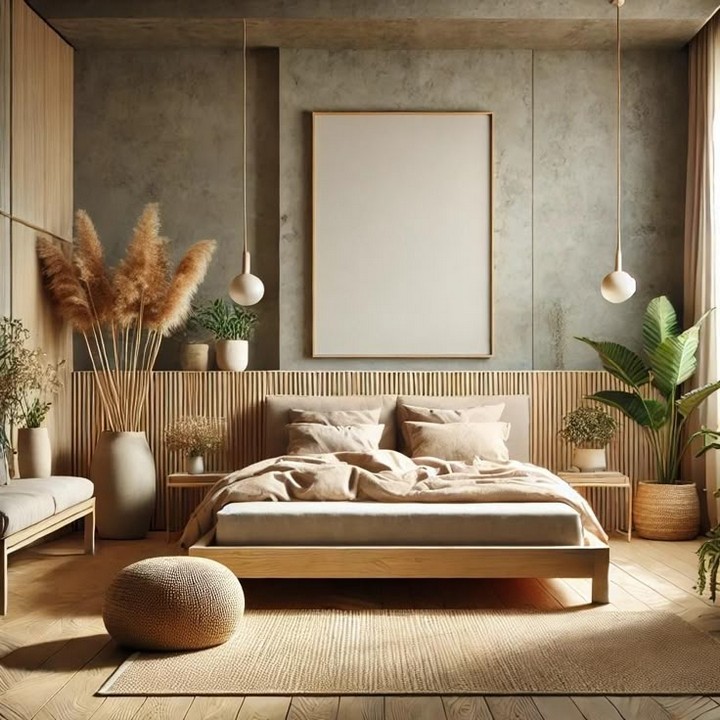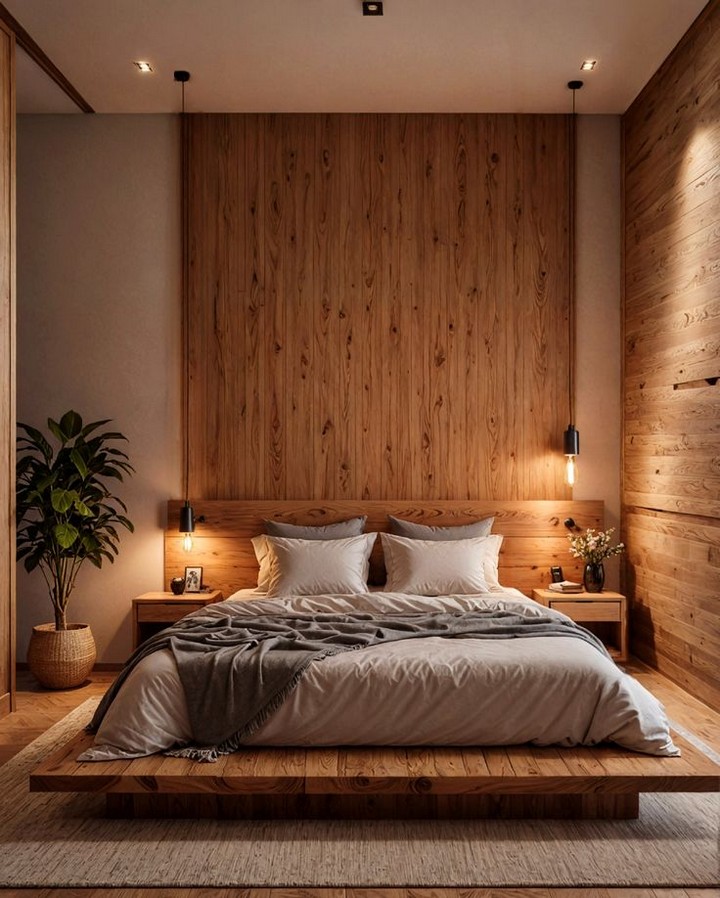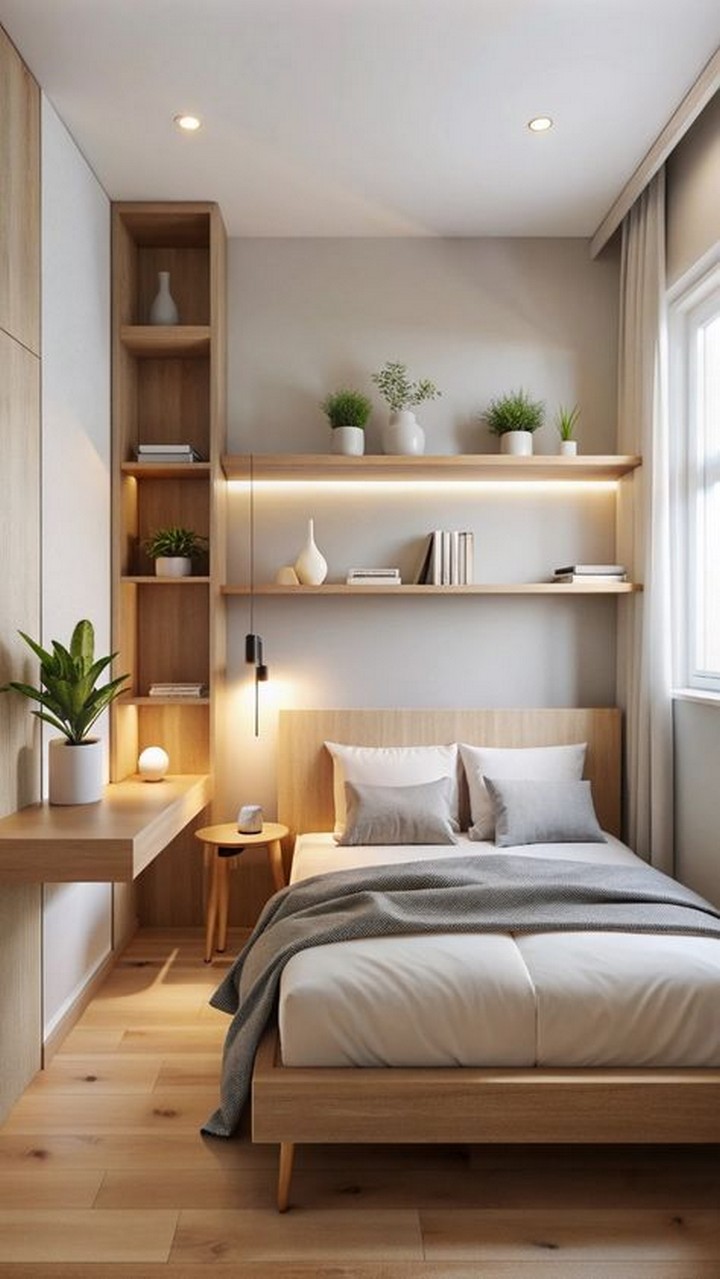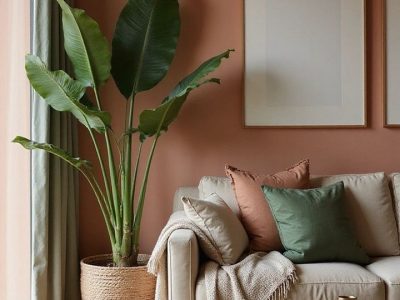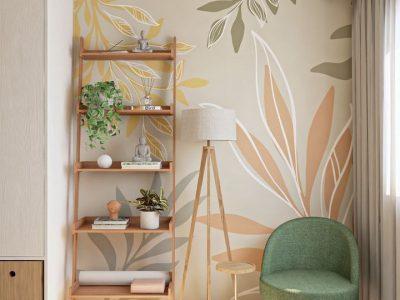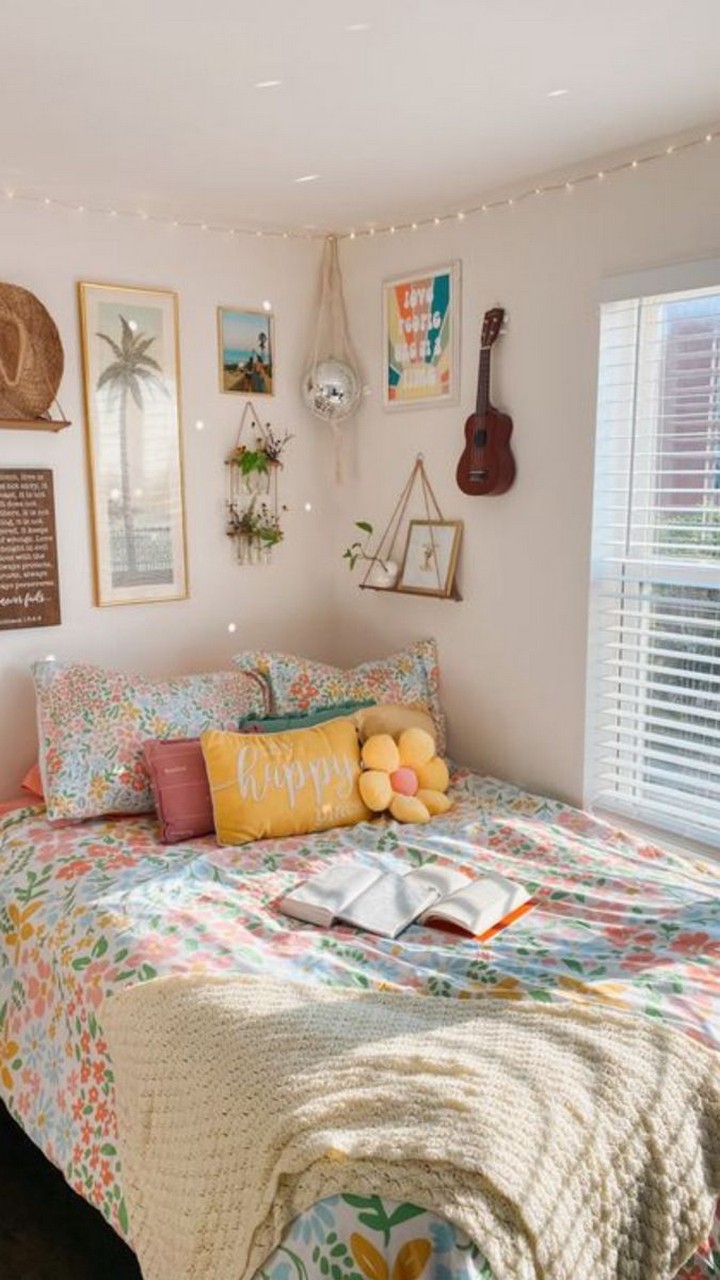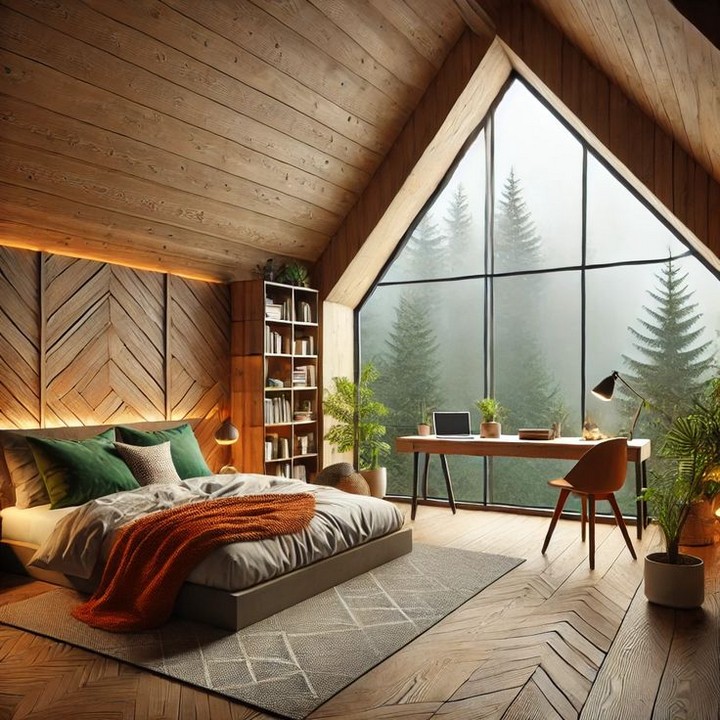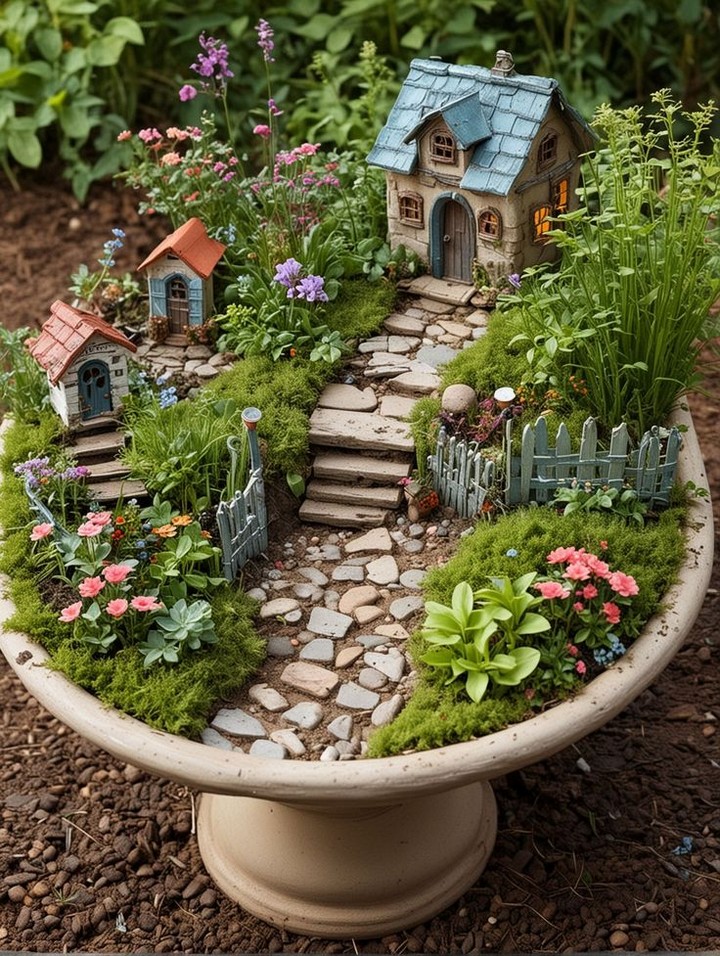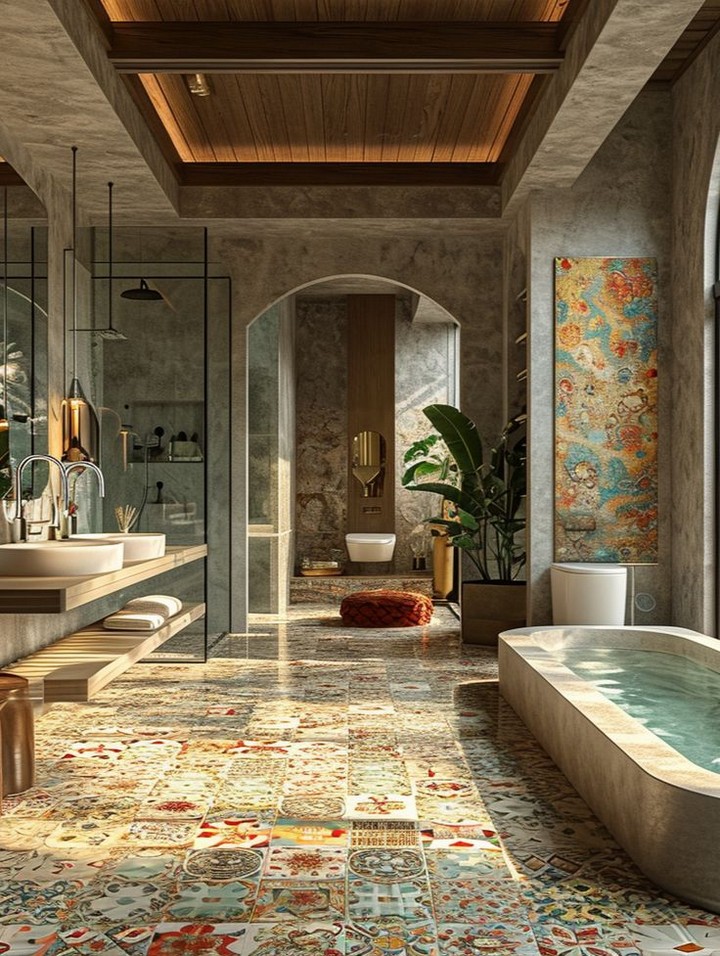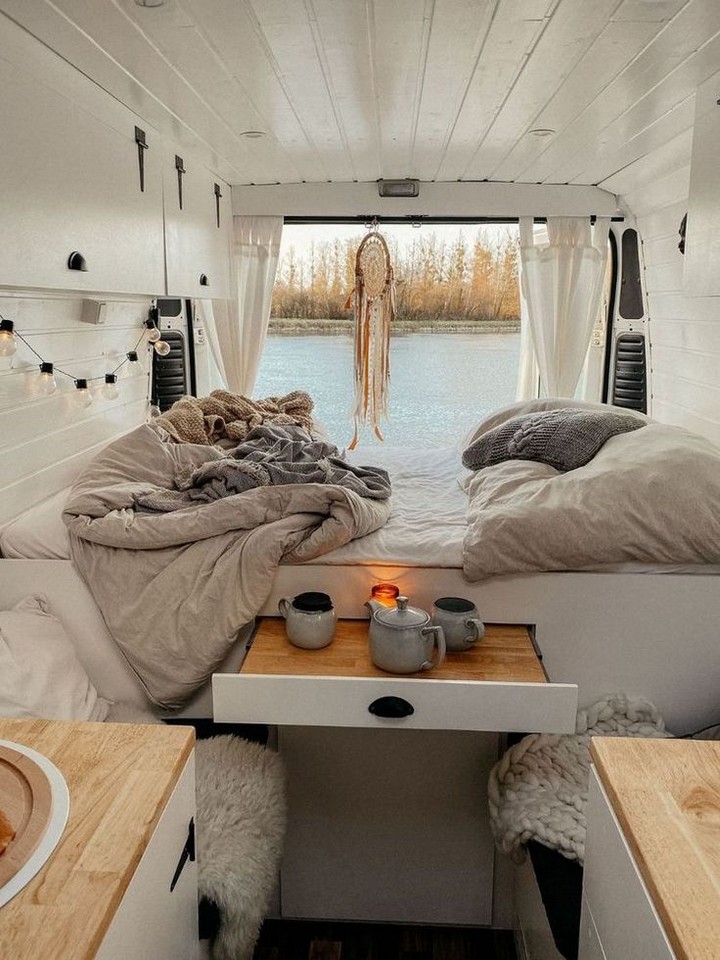In our fast-paced world, creating a peaceful bedroom sanctuary has never been more important. The minimalist aesthetic, combined with soothing earth tones, offers the perfect solution for those seeking both simplicity and comfort in their most intimate space. This harmonious design approach not only declutters your physical environment but also provides mental clarity and relaxation essential elements for quality rest and rejuvenation.
The minimalist earth-tone bedroom concept marries two powerful design principles: the “less is more” philosophy of minimalism and the grounding, nurturing qualities of natural color palettes. This combination creates spaces that feel simultaneously sophisticated and comforting modern yet timeless. Now, let’s explore 40 specific ways to create your own cozy minimalist bedroom with earth tones:
Foundational Design Elements
1. Natural Material Bed Frame
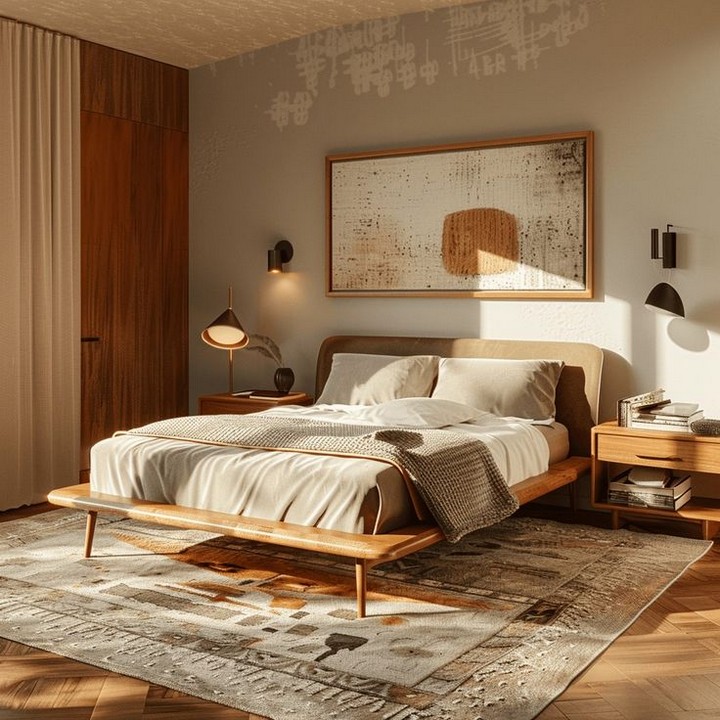
Opt for a simple wooden bed frame in oak, walnut, or ash. The natural grain adds organic texture while maintaining clean lines. Platform beds with integrated storage drawers offer functionality without compromising aesthetics.
2. Textured Wall Treatments
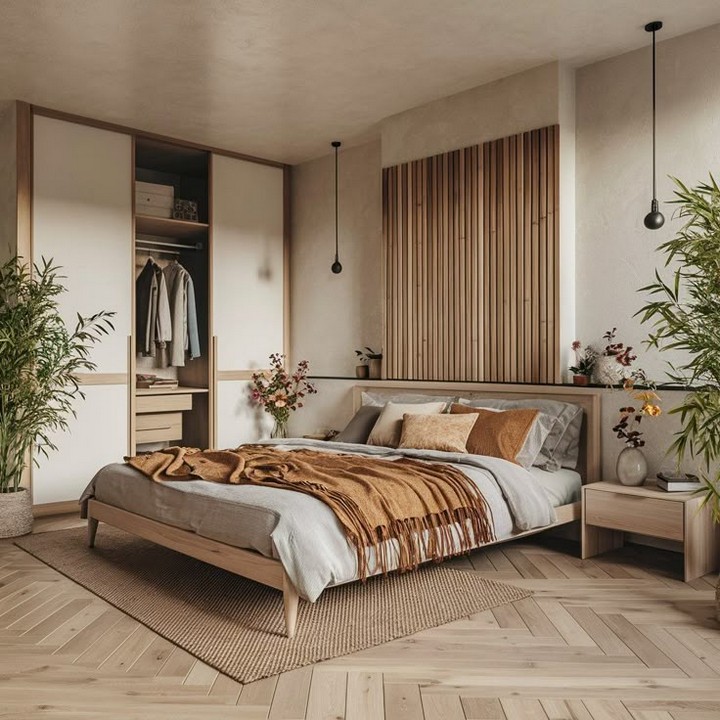
Consider subtle textured wall finishes like:
- Lime wash paint in sand or clay tones
- Textured plaster in warm beige
- Natural clay finishes for chemical-free air purification
These add dimension without pattern, creating visual interest while maintaining minimalist principles.
3. Hidden Storage Solutions
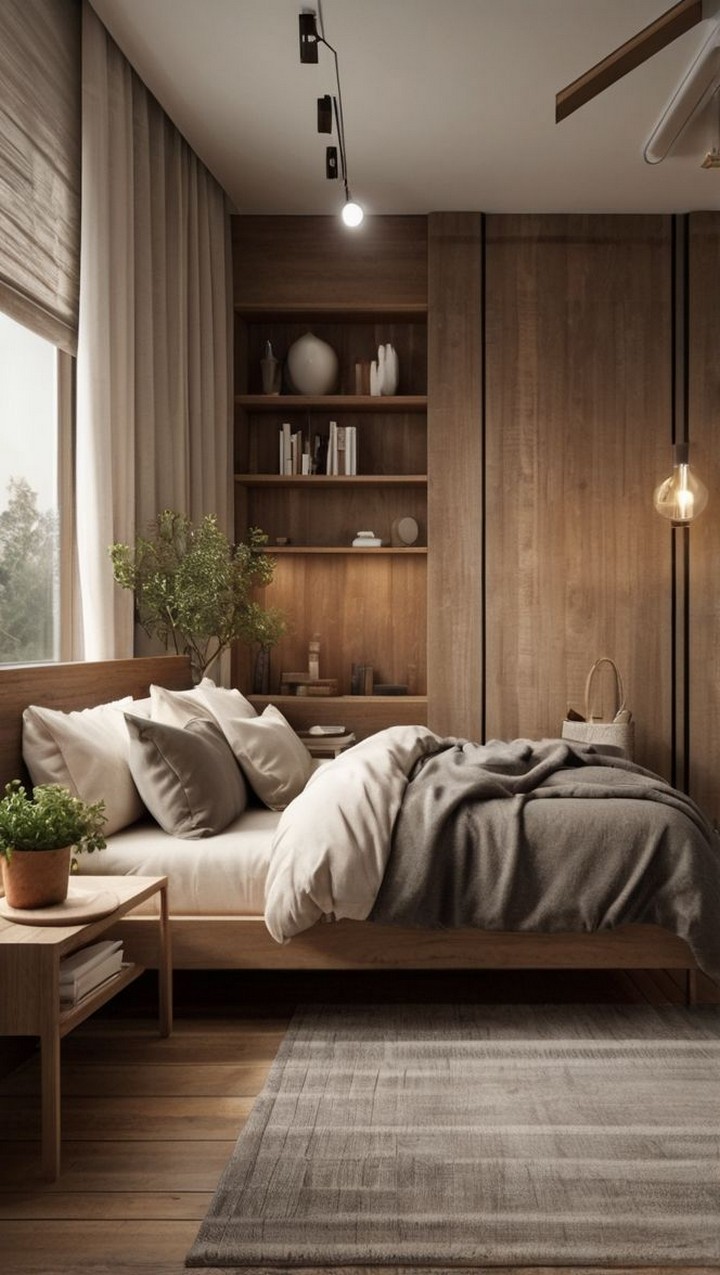
Embrace furniture that conceals clutter:
- Under-bed drawers
- Ottoman benches with storage
- Wall-mounted nightstands with concealed compartments
This maintains clean lines while addressing practical storage needs.
4. Layered Bedding in Tonal Variations

Create depth through subtle variations in similar earth tones:
- Oatmeal sheets
- Taupe duvet cover
- Terra cotta throw blanket
- Sand-colored pillows
The tonal variations add visual interest without introducing competing colors.
5. Strategic Lighting Zones
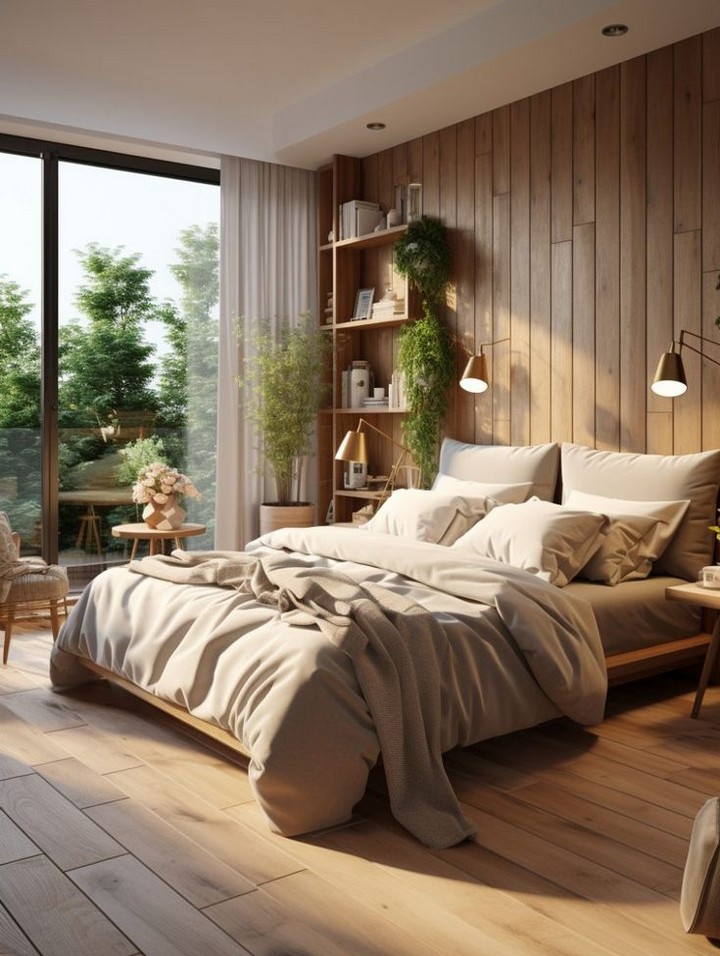
Create three lighting layers:
- Ambient lighting through simple ceiling fixtures or recessed lights
- Task lighting with minimalist wall sconces or table lamps
- Accent lighting like string lights in warm white
Choose fixtures with clean lines in materials like brass, black metal, or ceramic in earth tones.
Wall Treatments and Architecture
6. Earth-Tone Color Blocking
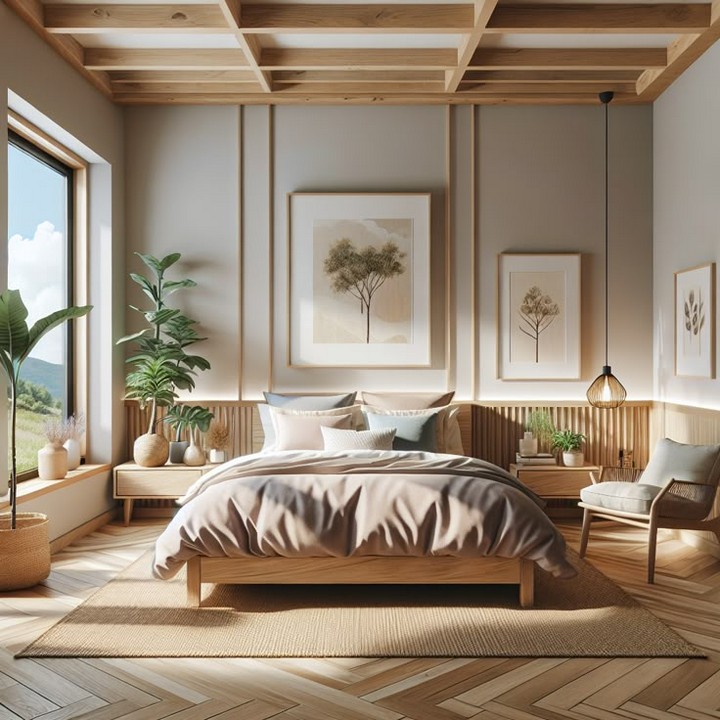
Add subtle architectural interest by painting part of a wall in a contrasting earth tone. For example, paint the lower third of your wall in terra cotta with the upper portion in warm white, creating a sophisticated yet simple feature.
7. Wabi-Sabi Inspired Plaster
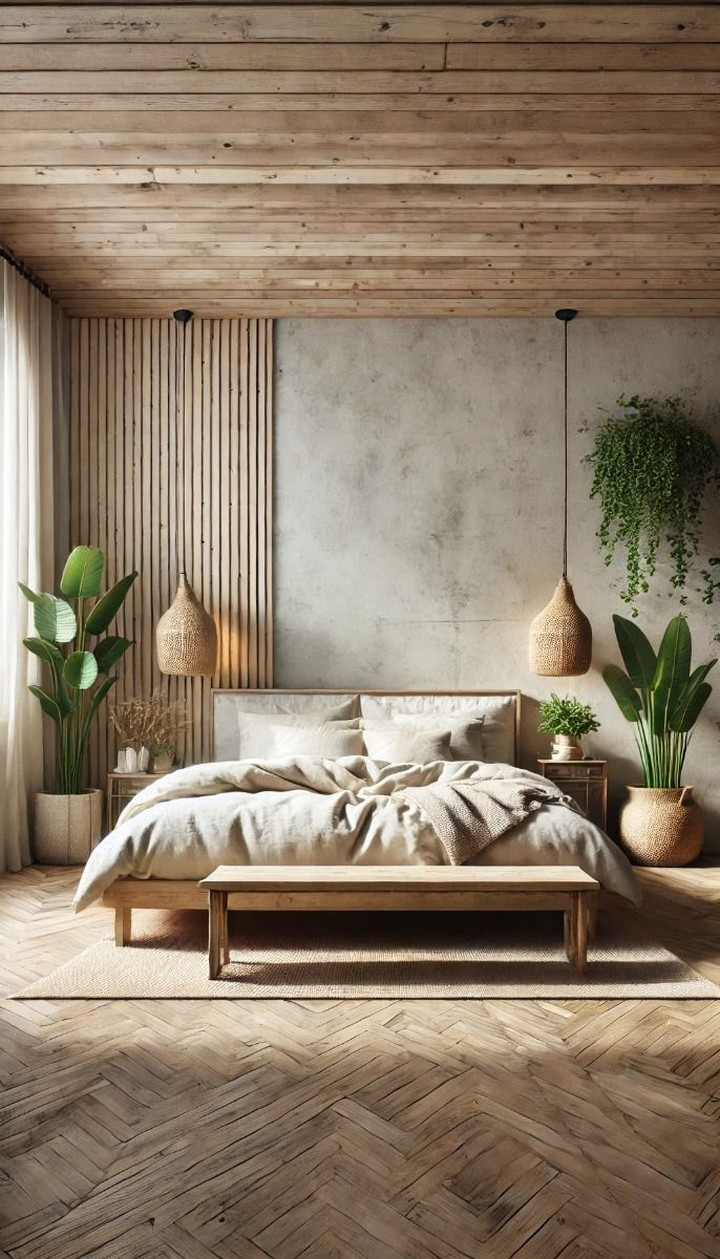
Embrace imperfection with hand-applied plaster walls in soft taupe or sand tones. The slight variations and texture add character while maintaining a minimalist feel.
8. Natural Material Panels
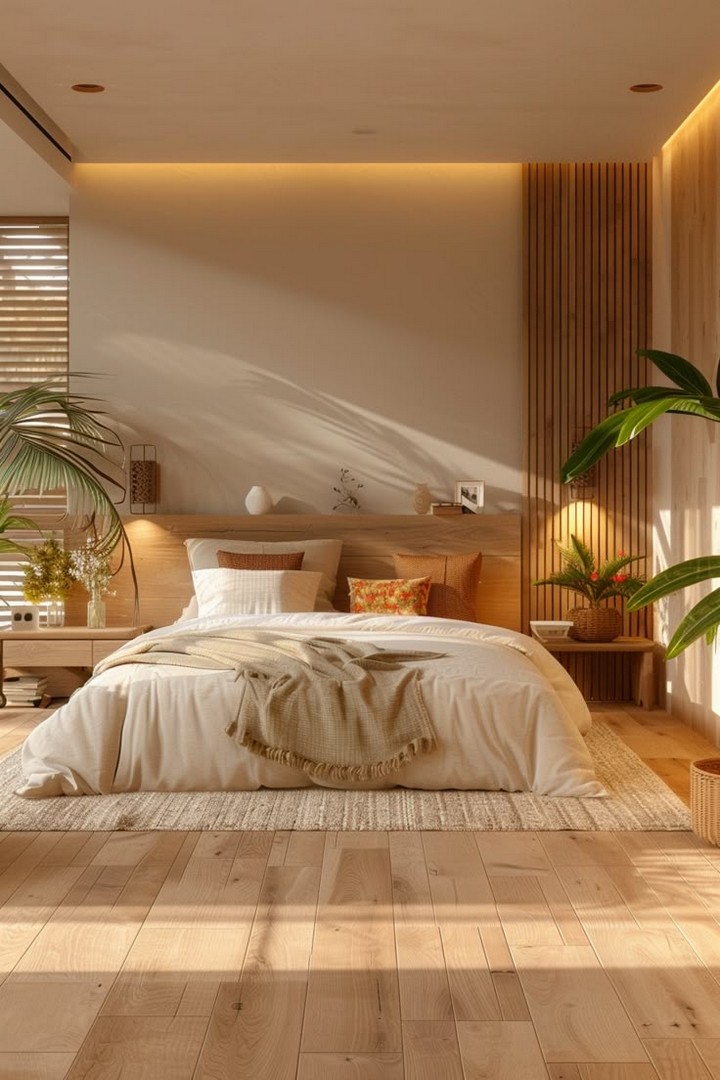
Install partial wall panels in materials like:
- Sustainably sourced wood slats
- Woven jute or sisal
- Cork panels
These create textural interest without overwhelming the space.
9. Warm Minimalist Trim
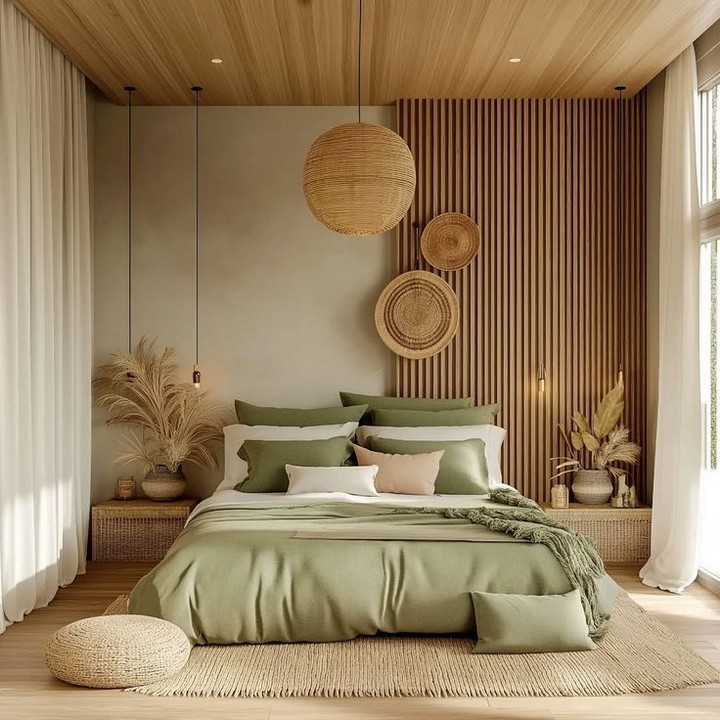
Replace standard white trim with wood-toned or earth-toned alternatives that blend more seamlessly with your palette, reducing visual clutter while adding subtle sophistication.
10. Clay Paint Finishes
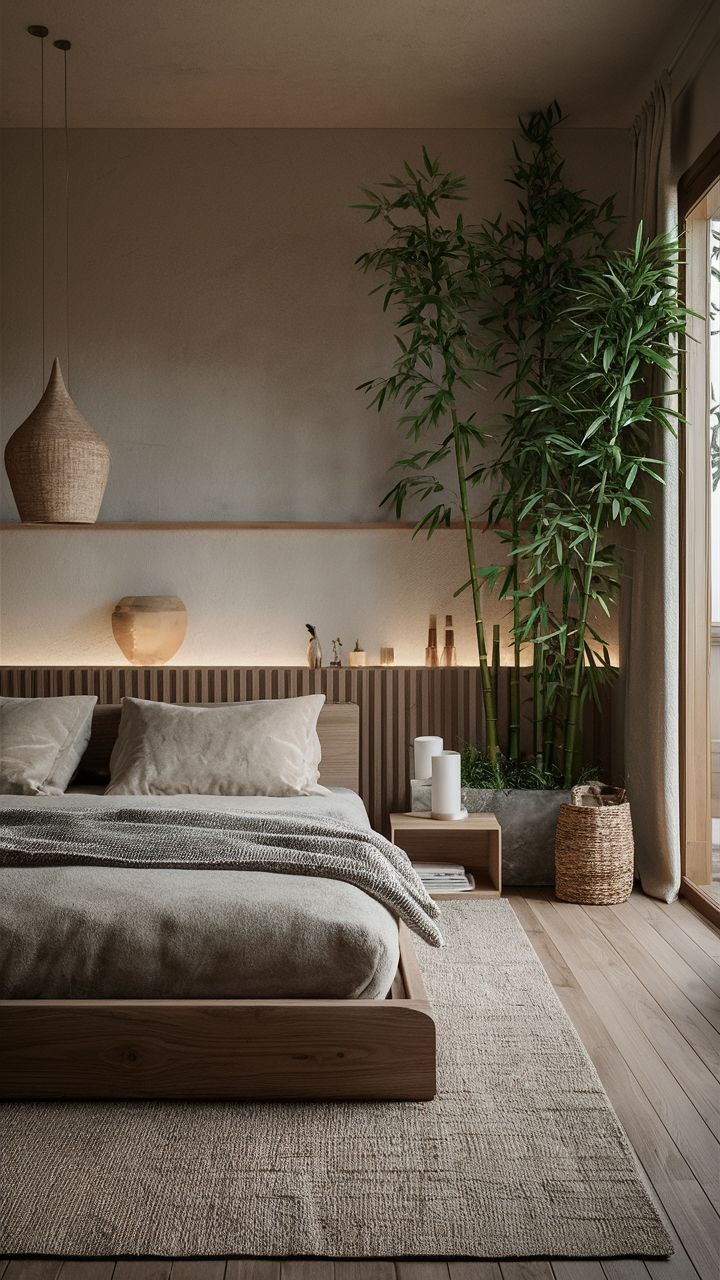
Explore non-toxic clay-based paints in colors like soft terracotta or sandy beige. These paints offer excellent depth and subtle texture while improving indoor air quality.
Furniture Selection and Arrangement
11. Low-Profile Platform Bed
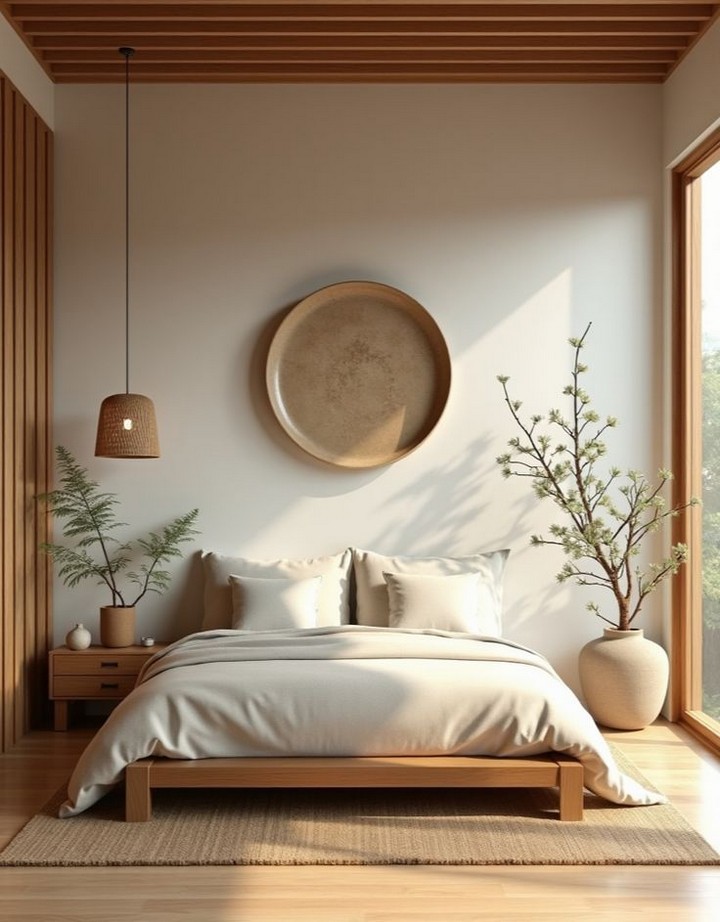
Choose a platform bed that sits close to the ground, creating a sense of spaciousness. Opt for natural wood tones or upholstered options in oatmeal, taupe, or olive linen.
12. Multifunctional Bench
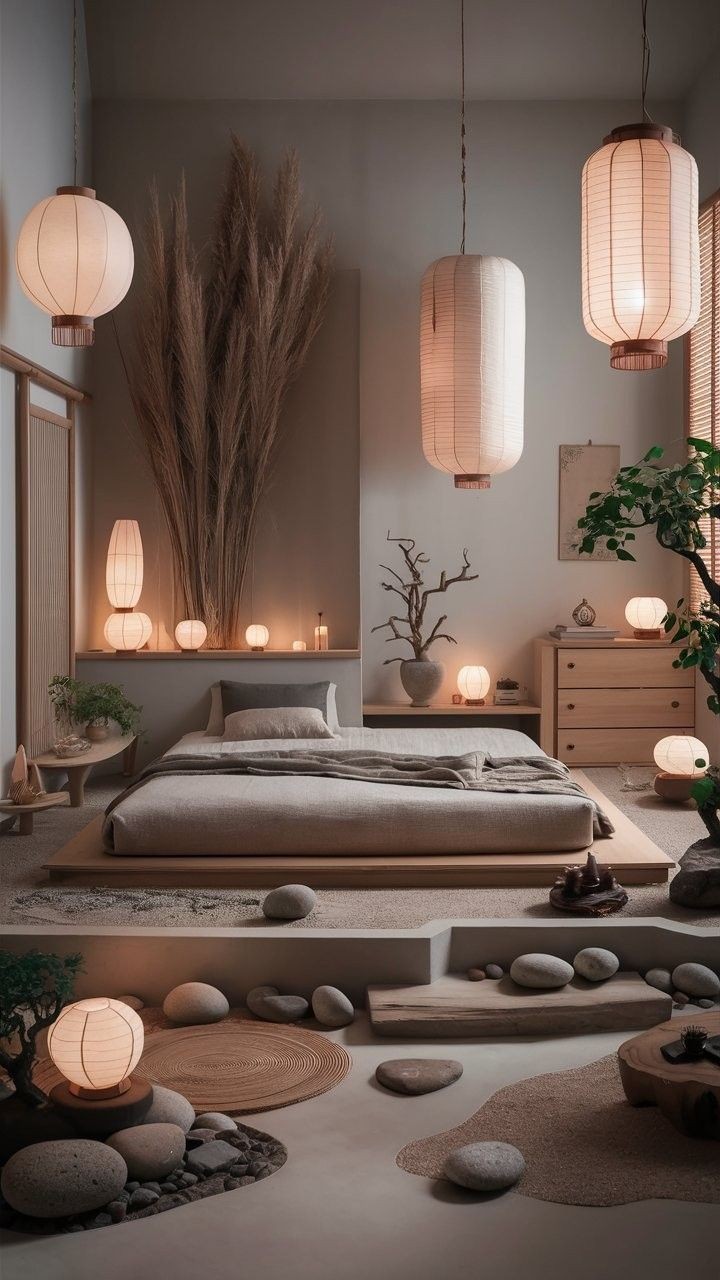
Place a simple bench at the foot of your bed in a complementary earth tone. It provides a place to sit while adding an architectural element that extends the horizontal line of your bed.
13. Floating Nightstands
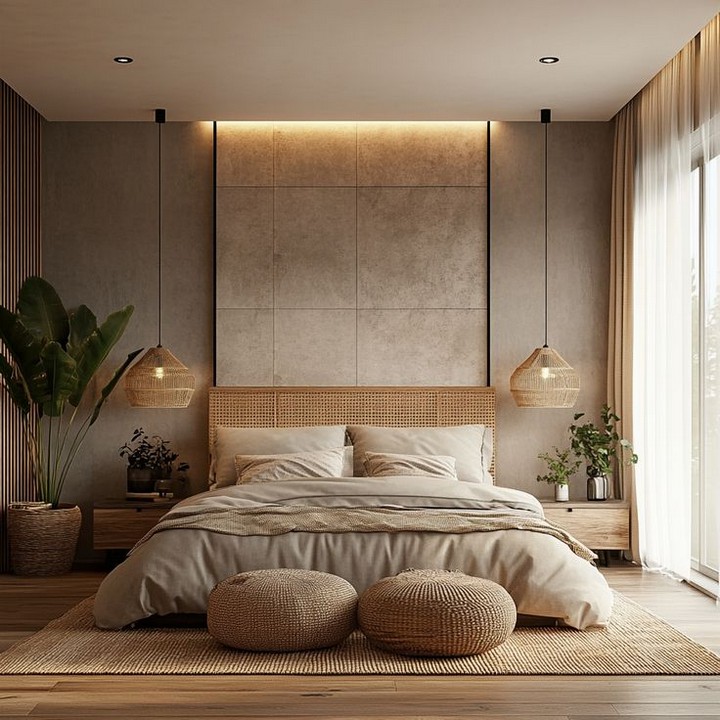
Replace traditional bulky nightstands with wall-mounted floating shelves or compact wall-mounted drawers. This creates a sense of openness while maintaining functionality.
14. One Statement Chair
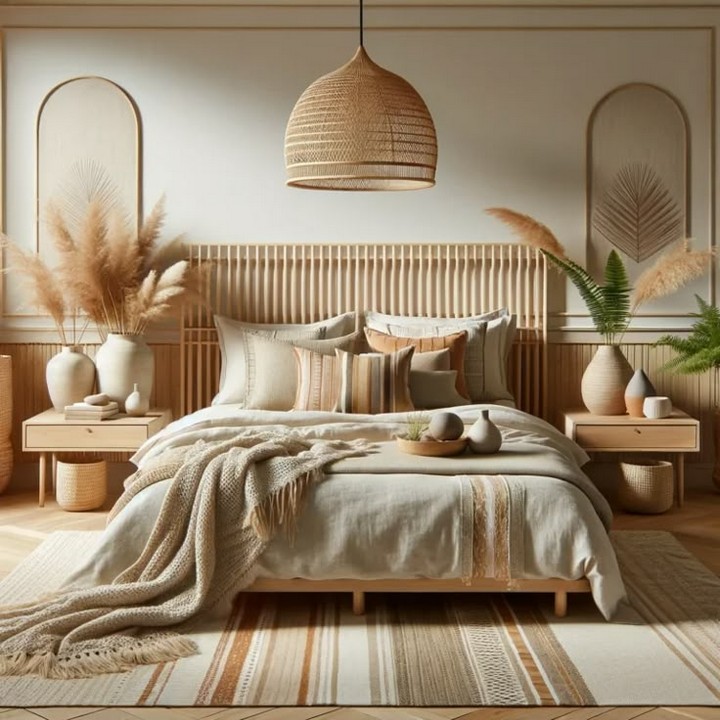
Rather than crowding the room with furniture, select one beautifully designed chair in an earth tone. This creates a deliberate focal point while providing practical seating.
15. Hidden Technology Solutions
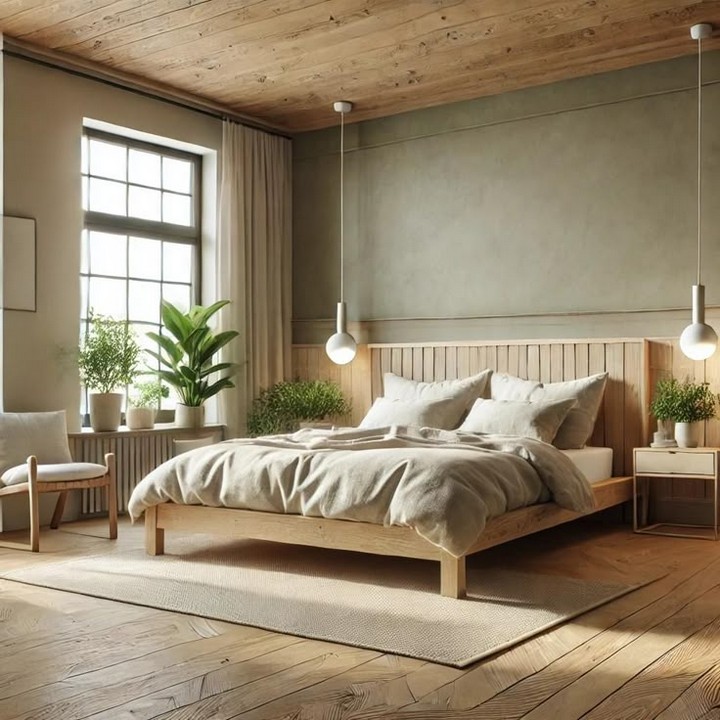
Select furniture that conceals technology:
- Media cabinets with cord management
- Charging stations built into nightstands
- Projector screens that retract into ceiling molding
This maintains the clean aesthetic of minimalism.
Textile Elements
16. Handcrafted Area Rug
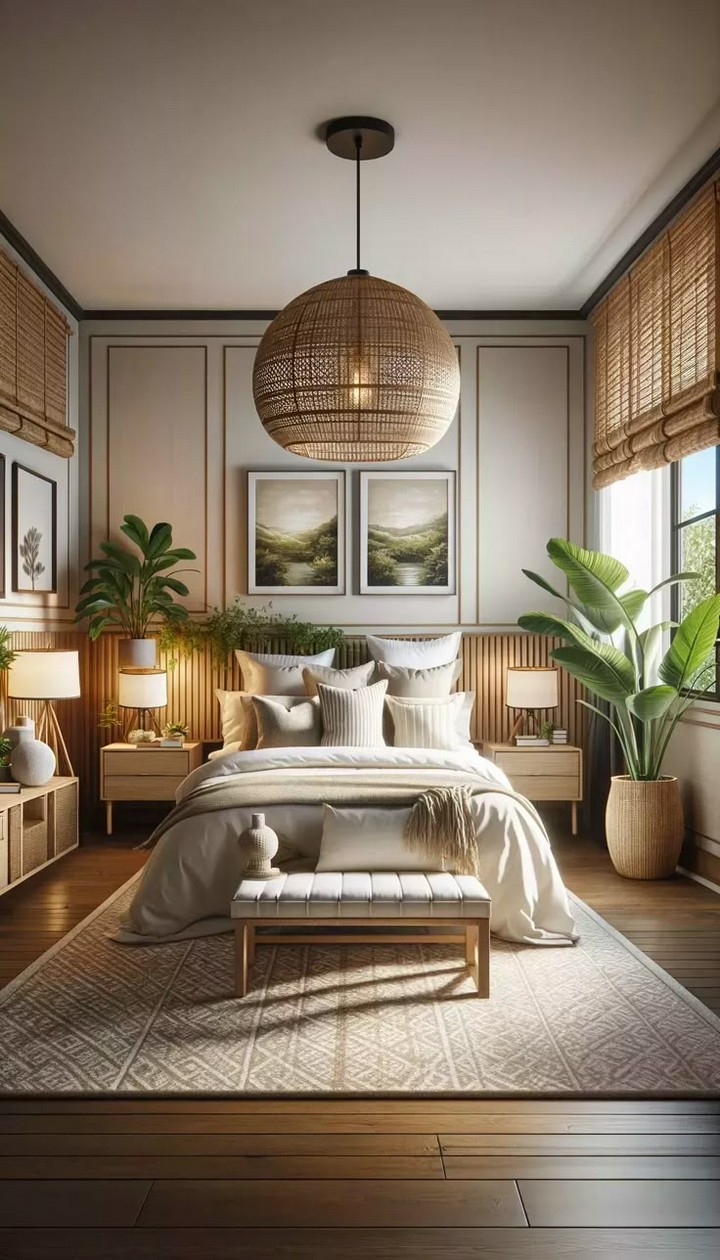
Anchor your room with a single, high-quality area rug in subtle earth tones. Look for options with minimal patterns—perhaps a simple geometric design or gentle color gradation.
17. Linen Curtains
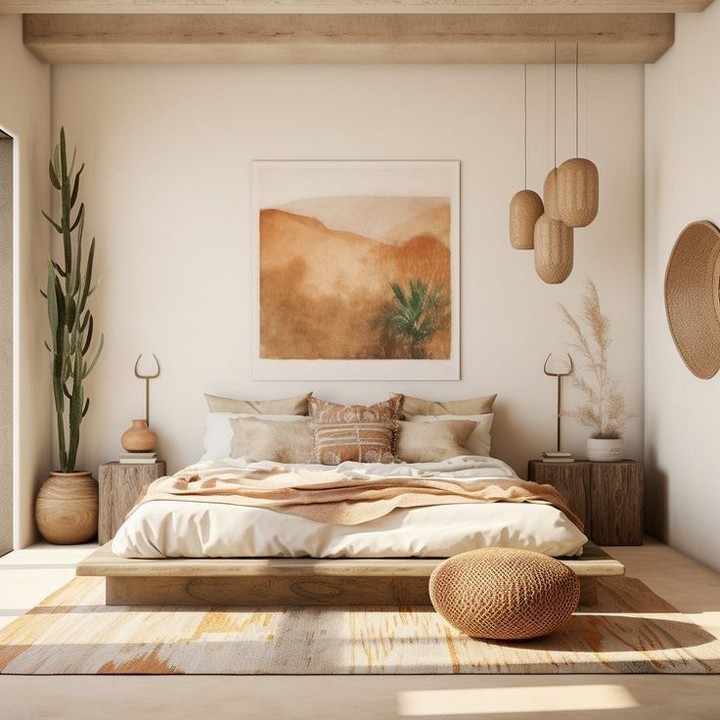
Choose unlined linen curtains in colors like oatmeal, sand, or olive. The natural texture filters light beautifully while maintaining a casual, organic feel.
18. Layered Bed Textures
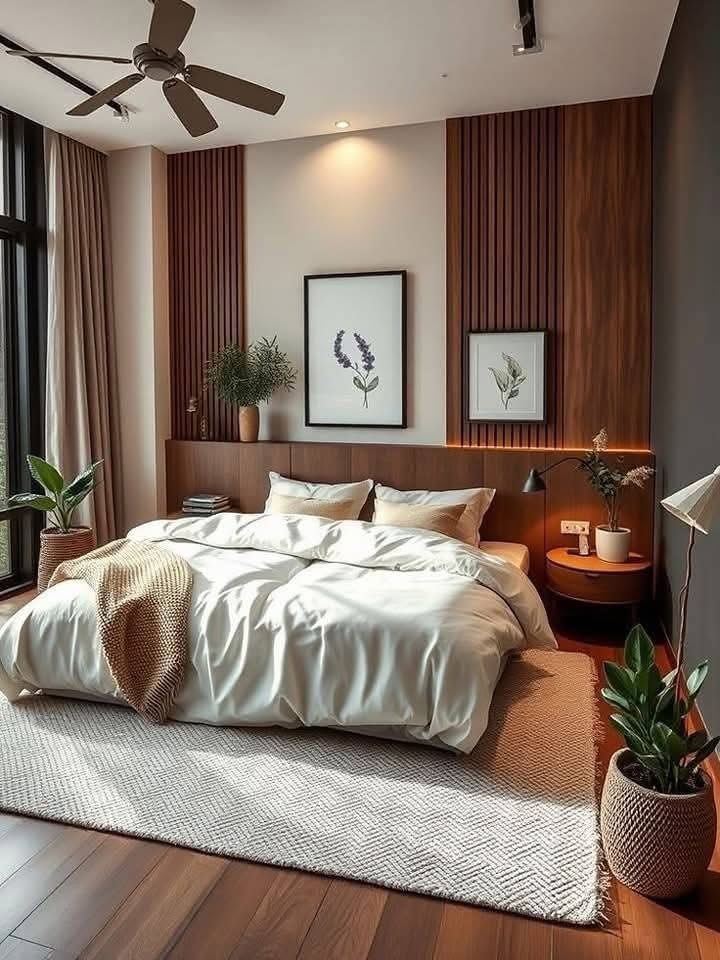
Create visual interest through texture rather than pattern:
- Linen sheets for a relaxed, breathable base
- Cotton or bamboo duvet cover for softness
- Wool or cotton throw for warmth and texture
- Linen or hemp pillow covers in complementary earth tones
19. One Accent Textile
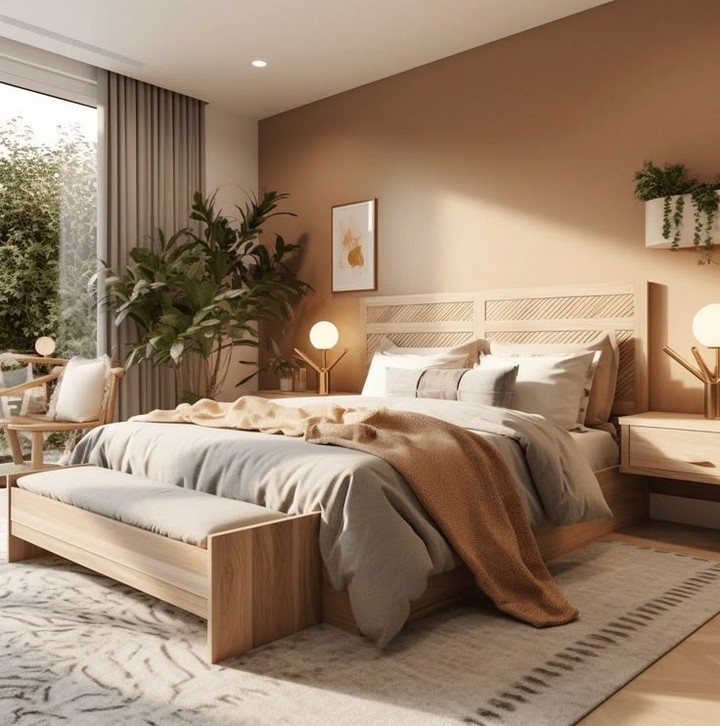
Introduce a single patterned element—like a lumbar pillow with a simple geometric pattern—to add personality without overwhelming the minimalist aesthetic.
20. Natural Fiber Basket
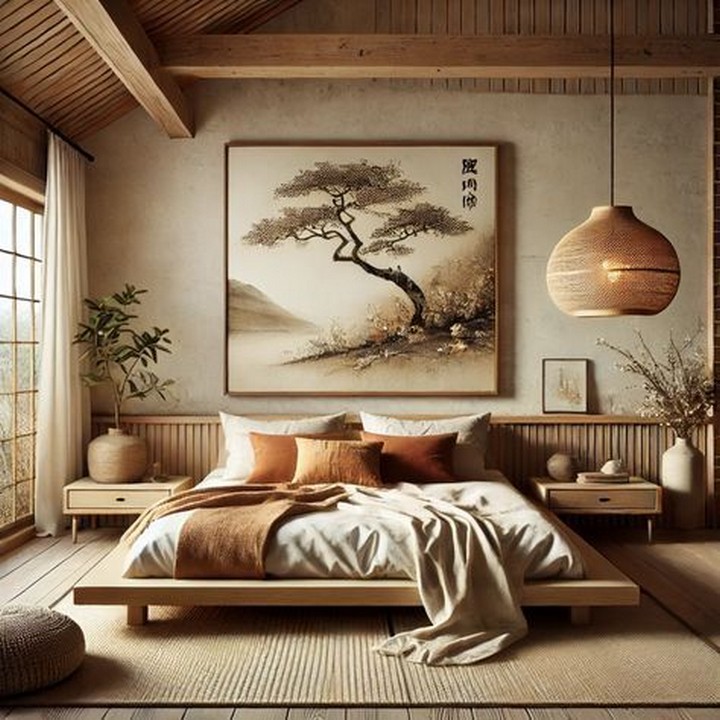
Use a handwoven basket in jute, seagrass, or water hyacinth as both decor and functional storage for extra blankets or pillows.
Lighting Concepts
21. Sculptural Light Fixture
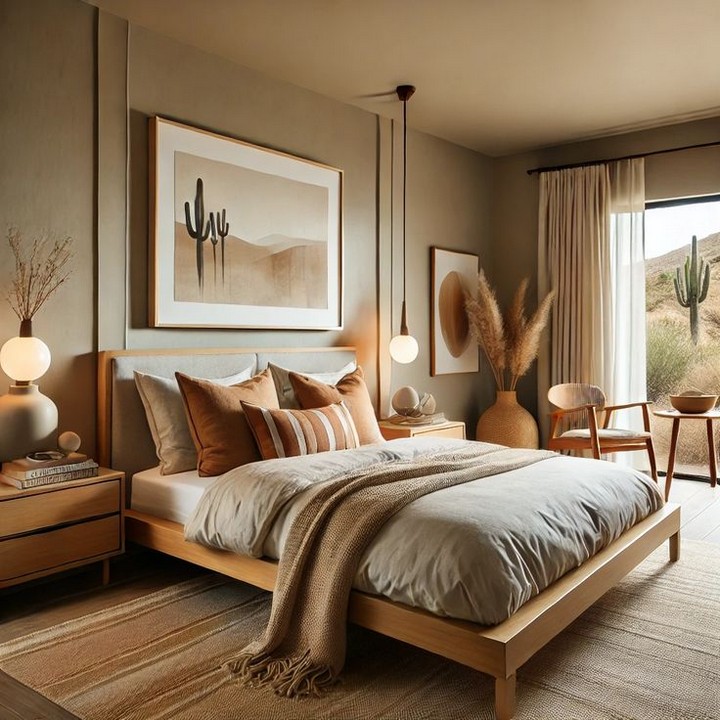
Install one statement light fixture with organic shapes or natural materials like ceramic, wood, or handmade paper. This creates a focal point without cluttering the space.
22. Integrated Reading Lights
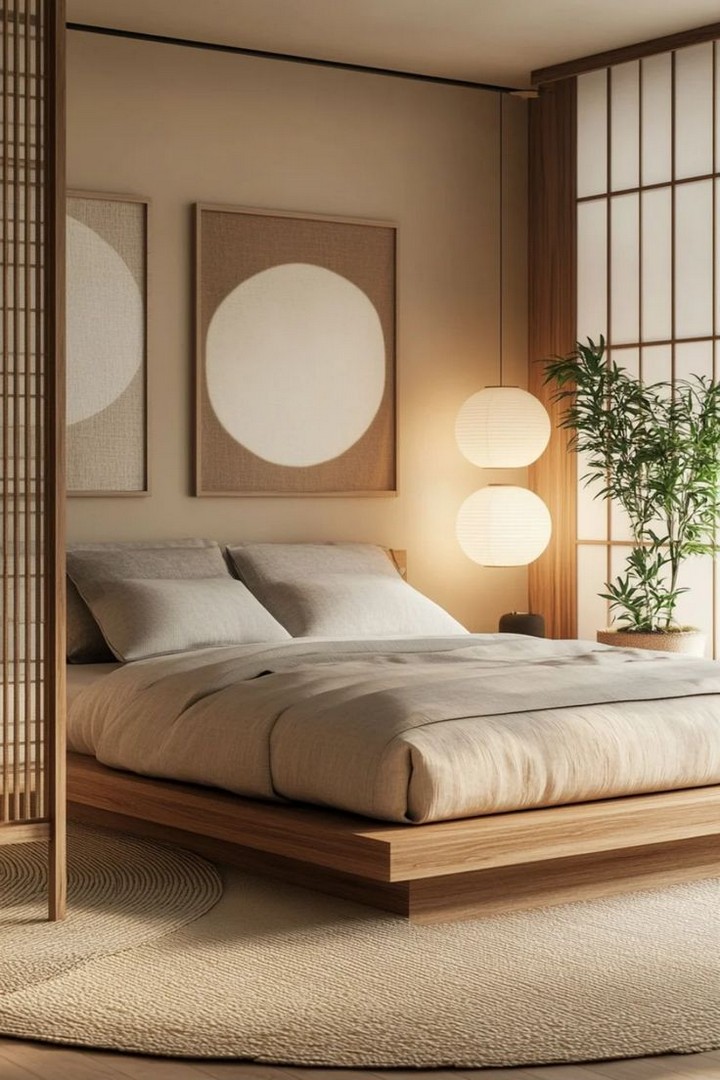
Choose wall-mounted reading lights with adjustable arms rather than table lamps to free up nightstand space and create clean lines.
23. Warm-Toned Light Bulbs
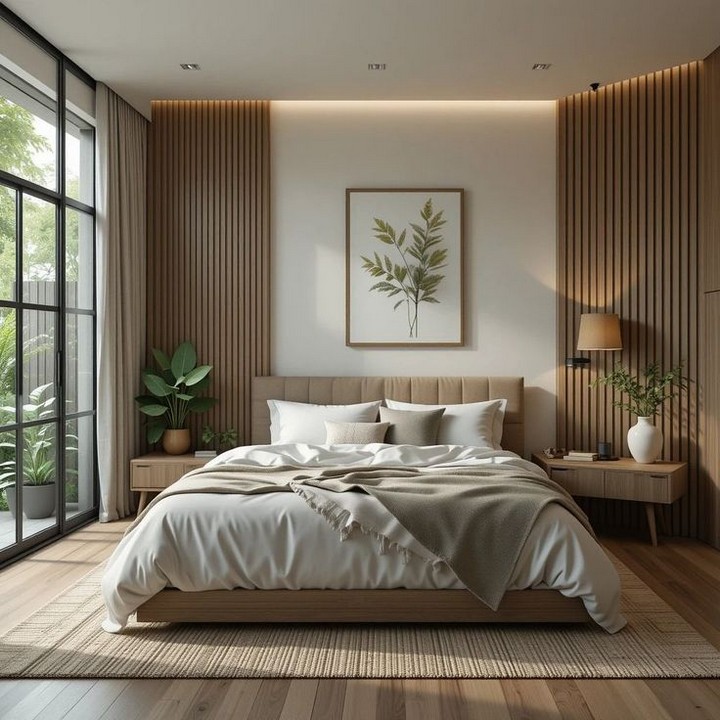
Select bulbs with a color temperature between 2700K-3000K to enhance your earth tone palette and create a cozy atmosphere.
24. Floor Uplighting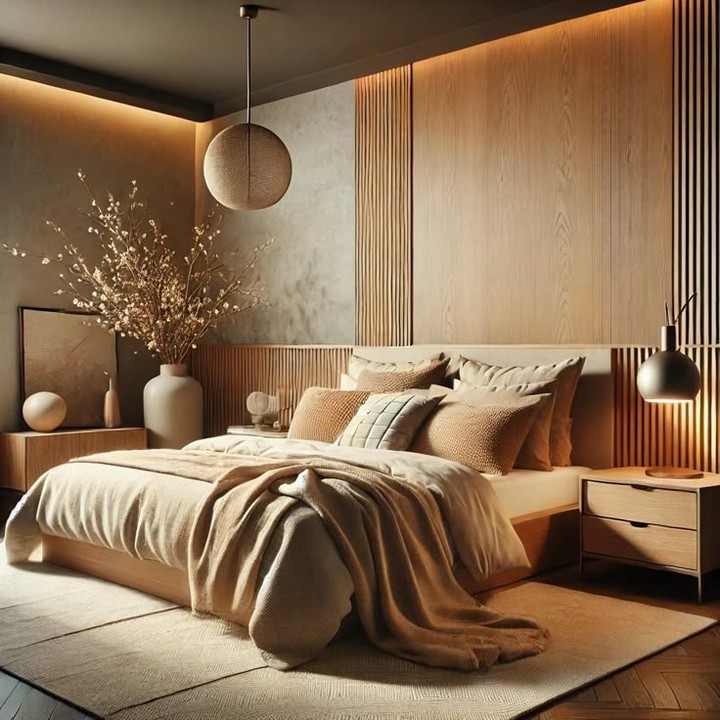
Place a simple floor uplighter in a corner to wash walls with gentle illumination, creating atmosphere without visual clutter.
25. Dimmable Solutions
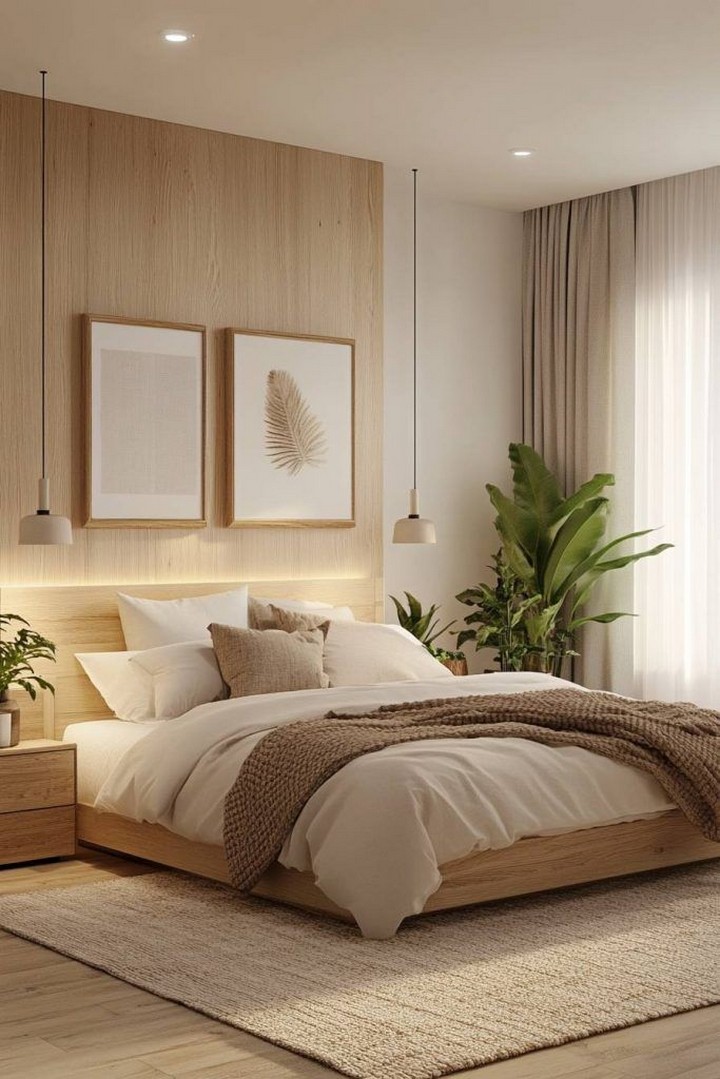
Install dimmer switches for all lighting to adjust ambiance according to time of day and mood—essential for a truly adaptable minimalist space.
Natural Elements
26. Single Statement Plant
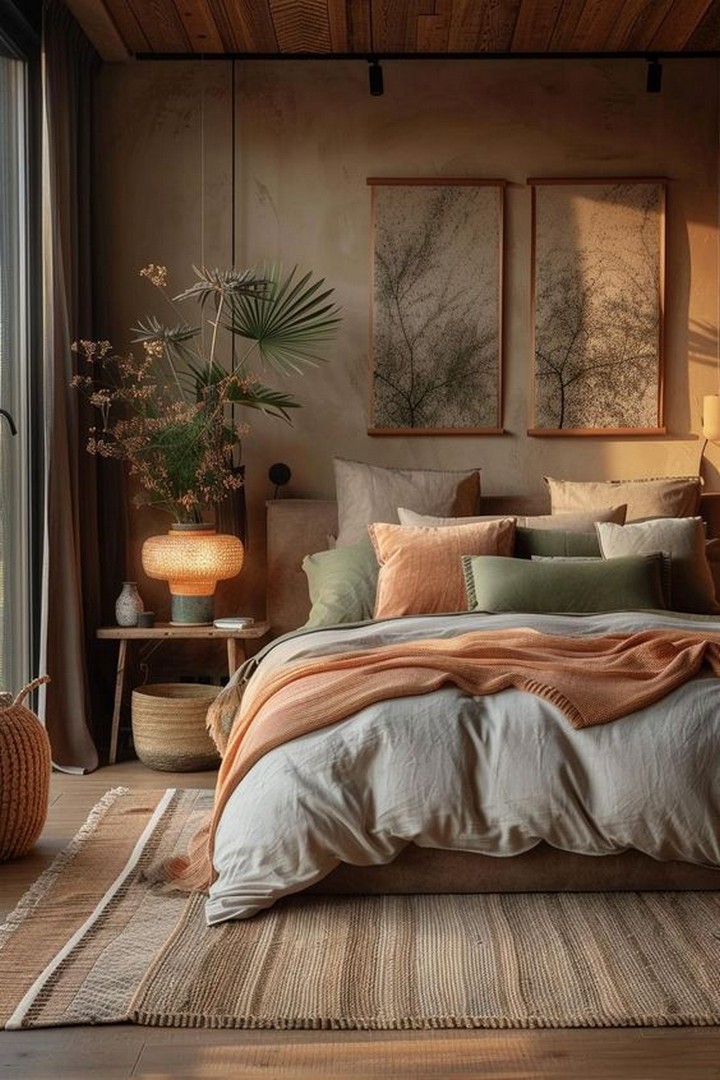
Rather than multiple small plants, select one larger statement plant like a:
- Fiddle leaf fig
- Olive tree
- Snake plant
- ZZ plant
Choose a simple planter in a complementary earth tone.
27. Natural Wood Elements
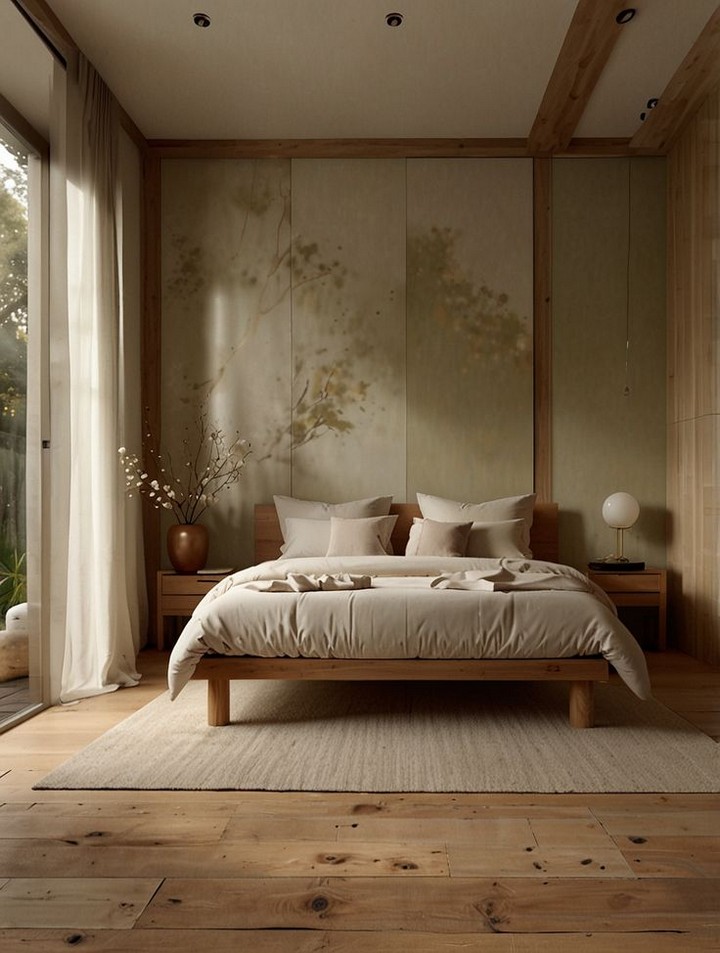
Incorporate untreated or lightly finished wood elements through:
- Raw edge floating shelves
- Reclaimed wood headboard
- Simple wooden stool or side table
28. Stone Accessories
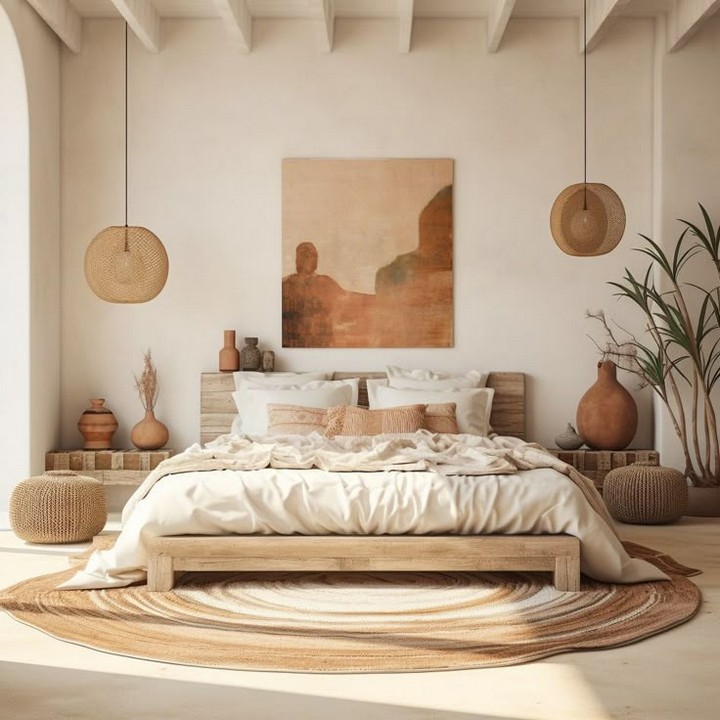
Add small stone elements like:
- Marble catchall dish
- Onyx bookends
- River stone paperweights
- Alabaster lamp base
These bring literal earth elements into your space.
29. Dried Botanical Arrangements
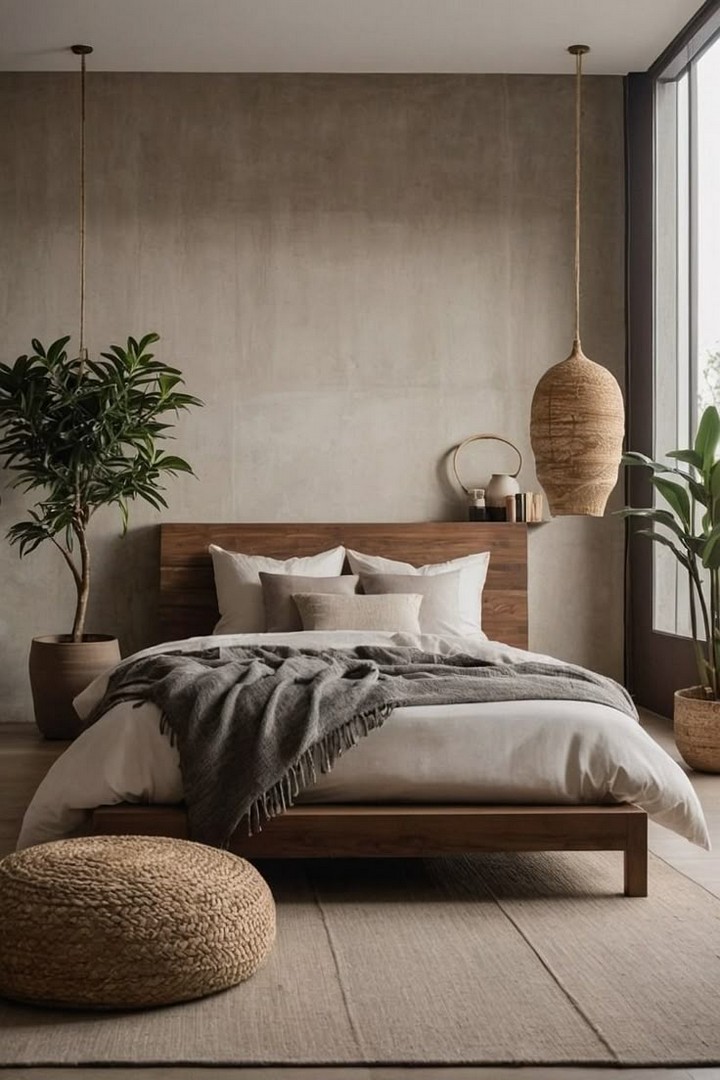
Replace high-maintenance fresh flowers with sustainable dried arrangements in neutral tones—pampas grass, dried eucalyptus, and preserved branches offer texture without color distraction.
30. Natural Fiber Objects
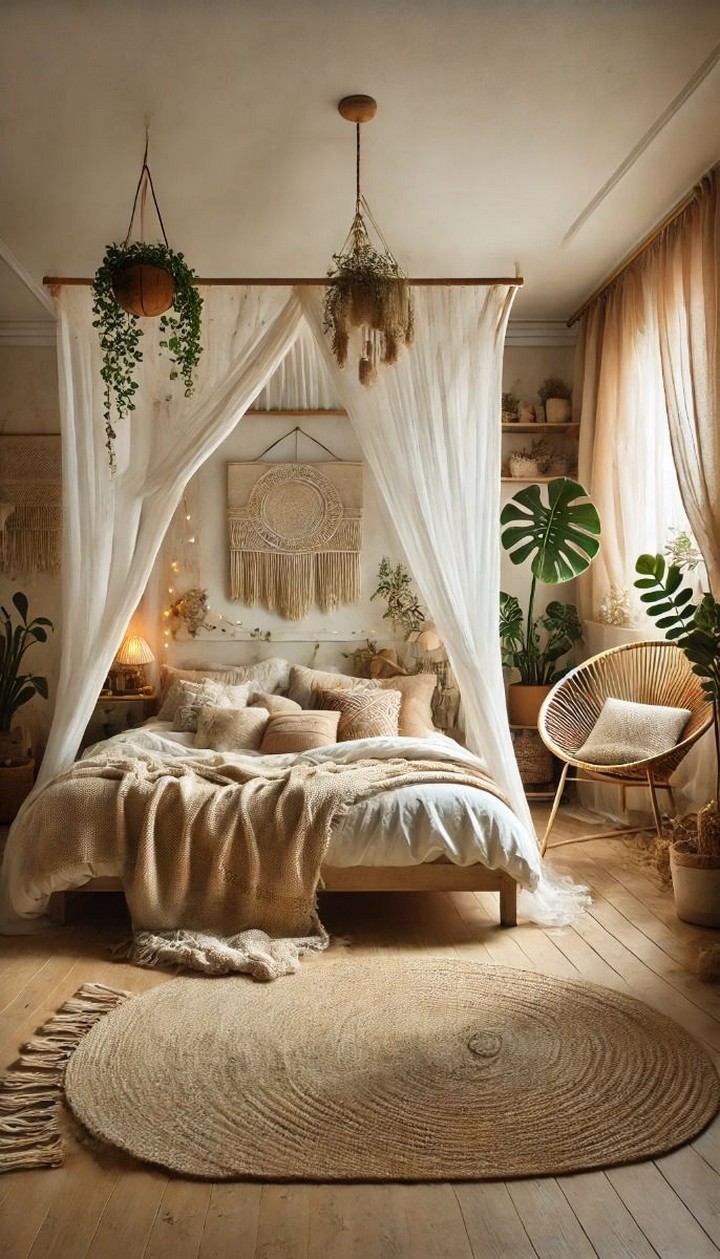
Incorporate handcrafted items made from natural fibers:
- Woven wall hanging in neutral tones
- Handmade paper lampshade
- Basket wall art
- Macramé plant hanger
Mindful Minimalist Accessories
31. Curated Art Selection
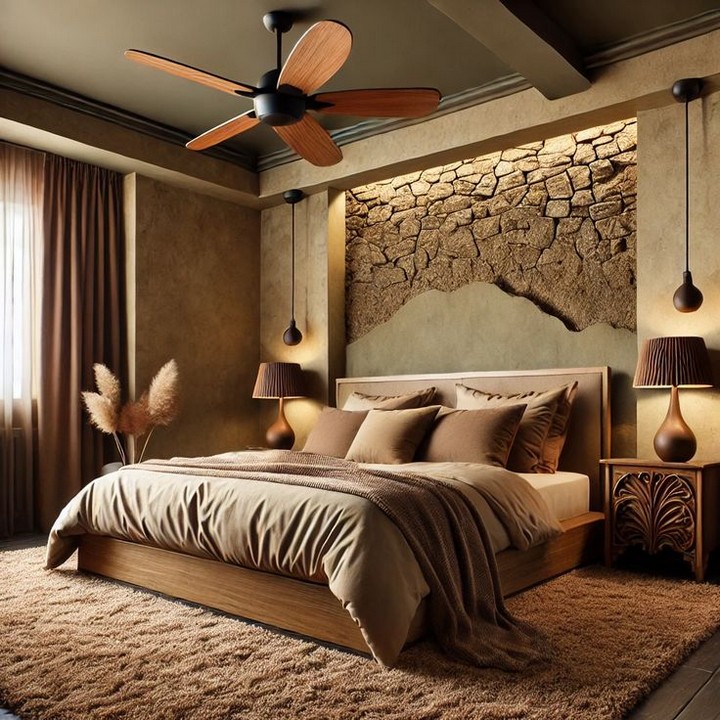
Choose one larger piece or a small collection of 2-3 artworks in earth tones. Consider:
- Abstract landscapes
- Textural mixed media
- Monochromatic photography
- Handmade ceramic wall art
32. Functional Sculpture
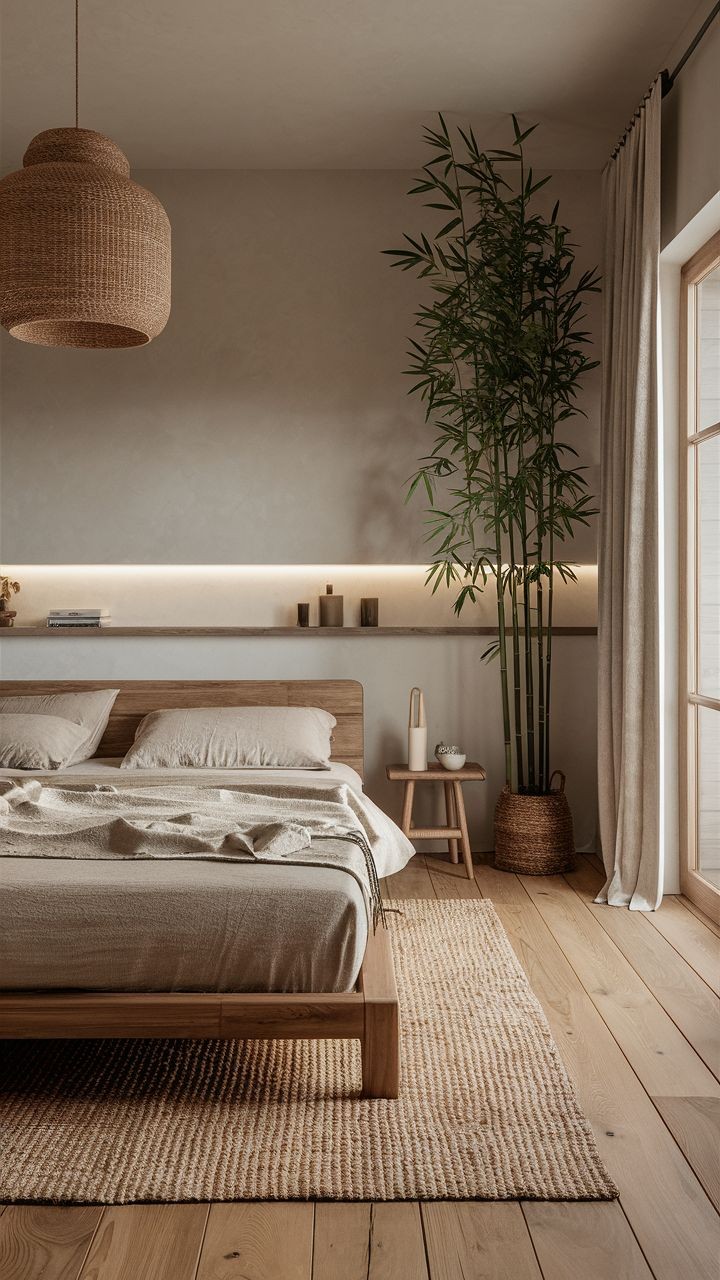
Select objects that serve dual purposes as both art and function:
- Sculptural ceramic vase
- Hand-carved wooden bowl
- Artisanal ceramic mug as bedside water vessel
- Beautifully designed alarm clock or speaker
33. Mirror Placement
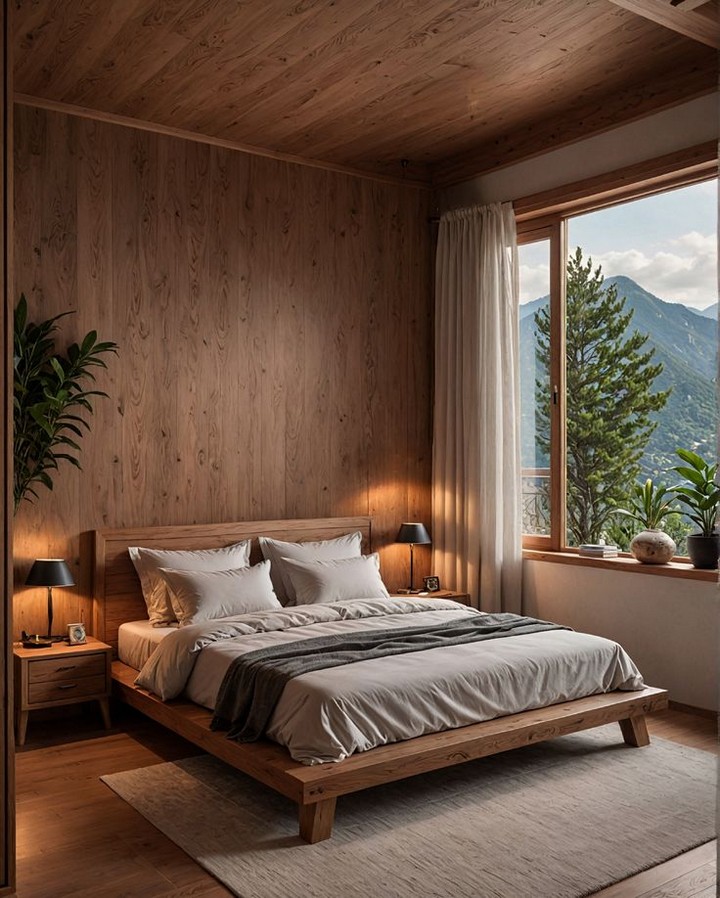
Use a simple-framed mirror to:
- Reflect natural light
- Create a sense of spaciousness
- Add functional value
- Serve as an architectural element
34. Mindful Technology Integration
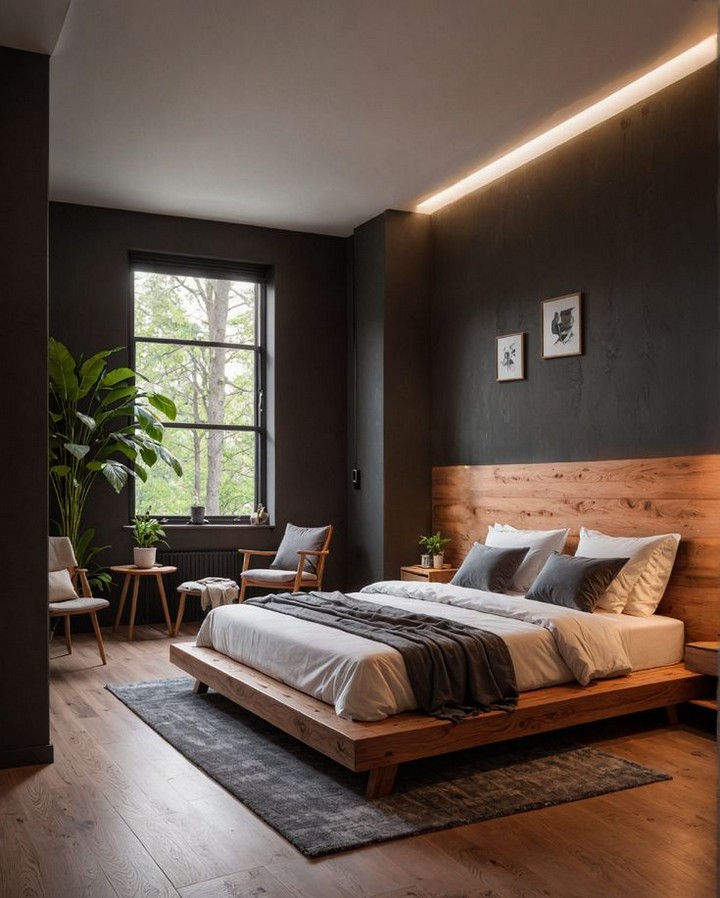
Hide or minimize technology presence:
- Wall-mounted television with art display mode
- Simple speaker systems in natural materials
- Charging stations hidden within furniture
- Projector instead of television
35. Quality Over Quantity Principle
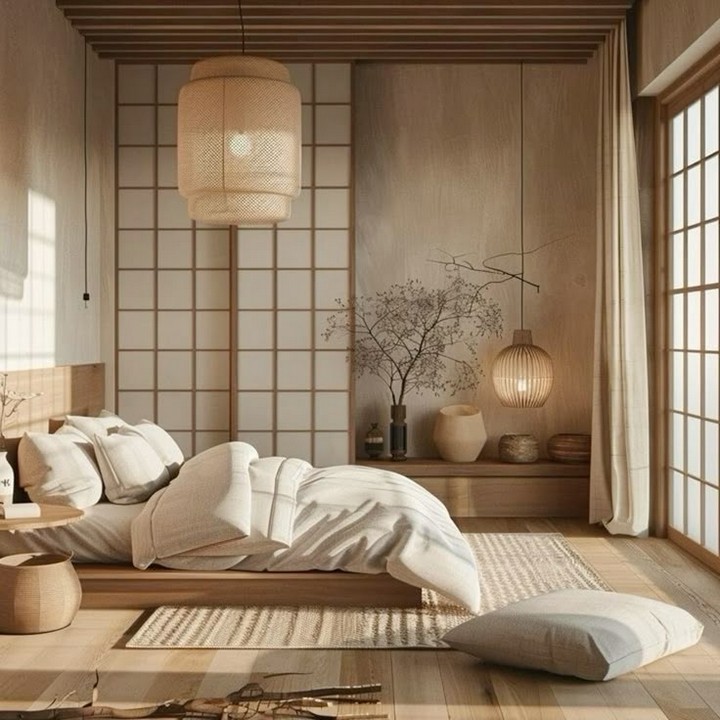
Rather than multiple cheaper accessories, invest in fewer, higher-quality pieces that will stand the test of time, both functionally and aesthetically.
Advanced Minimalist Strategies
36. Tonal Color Transition
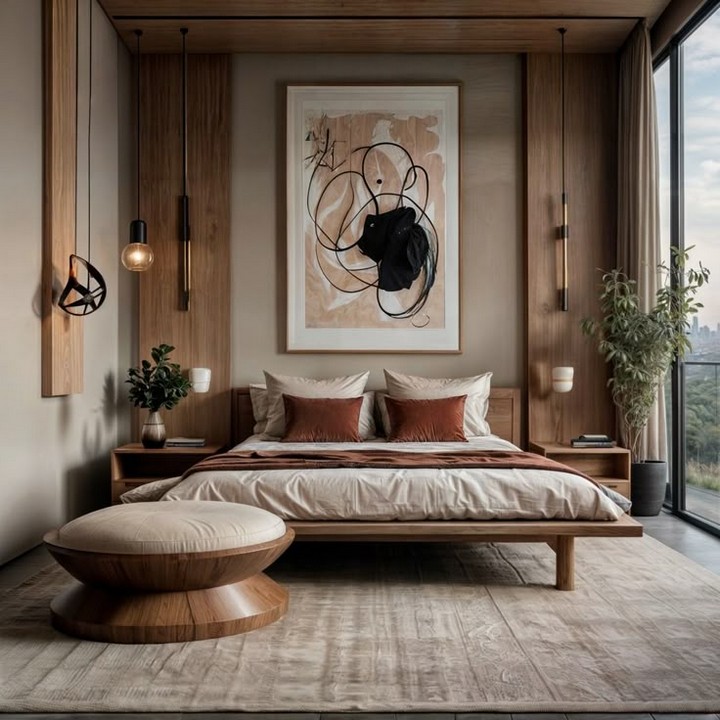
Create subtle zoning by using slightly different, but related earth tones in different areas of your bedroom. For example, shift from warmer to cooler neutrals as you move from bed to seating area.
37. Textural Contrast
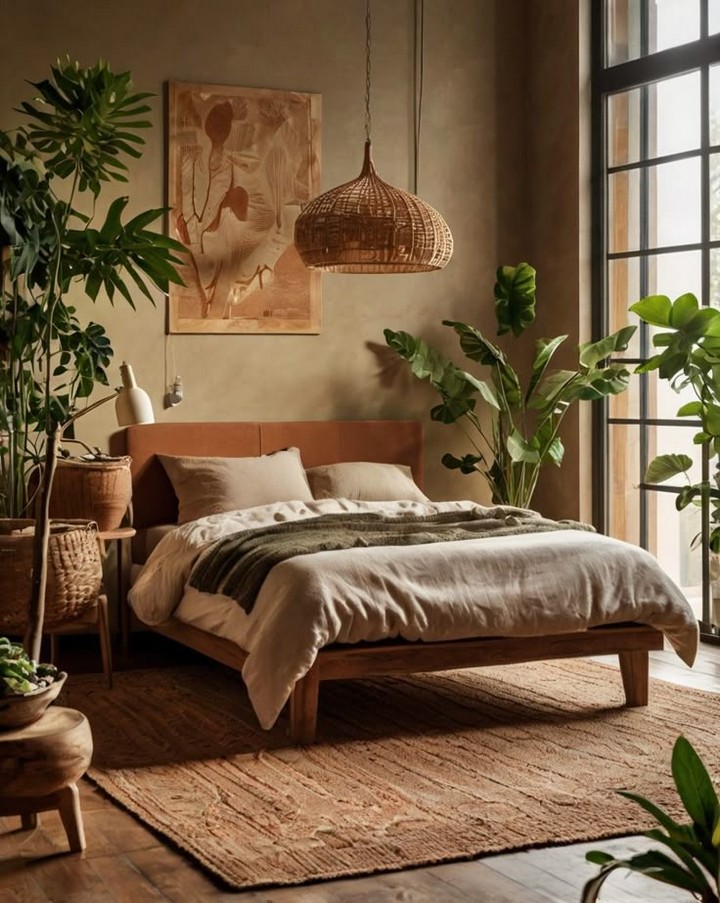
Play with contrasting textures while maintaining color harmony:
- Rough-hewn wood against smooth linen
- Nubby wool alongside sleek ceramic
- Matte walls with glossy accent pieces
- Soft textiles with metal elements
38. Negative Space Utilization
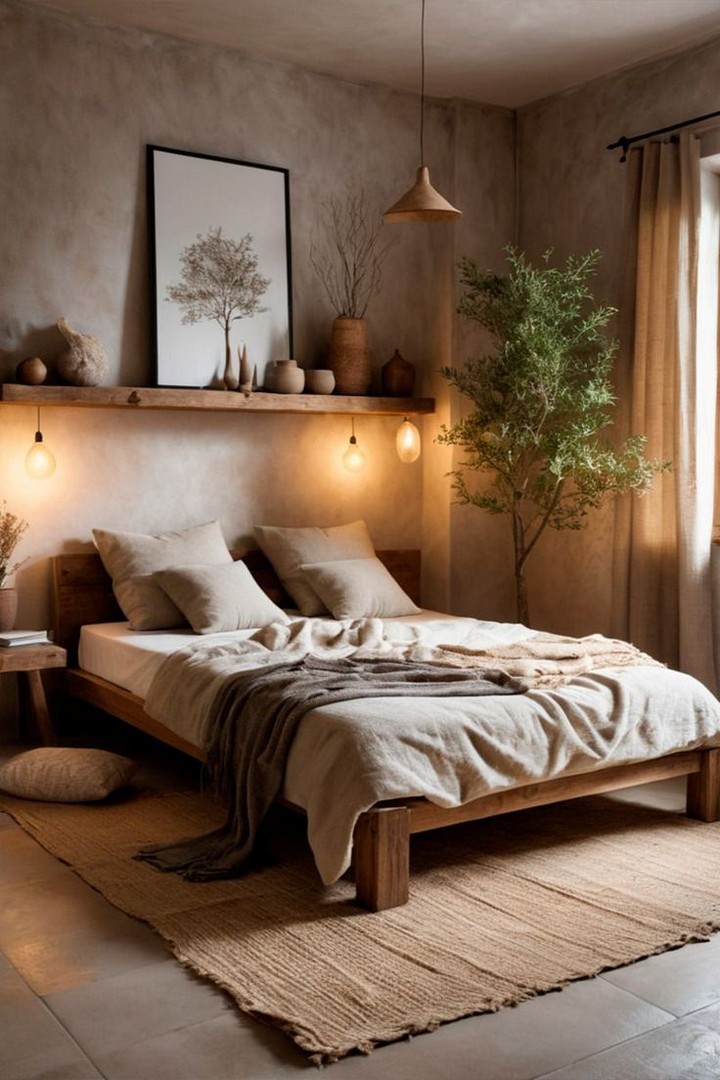
Embrace empty space as a design element—leave deliberate “breathing room” around furniture and decor items to highlight their forms and create visual calm.
39. Hideaway Workspaces
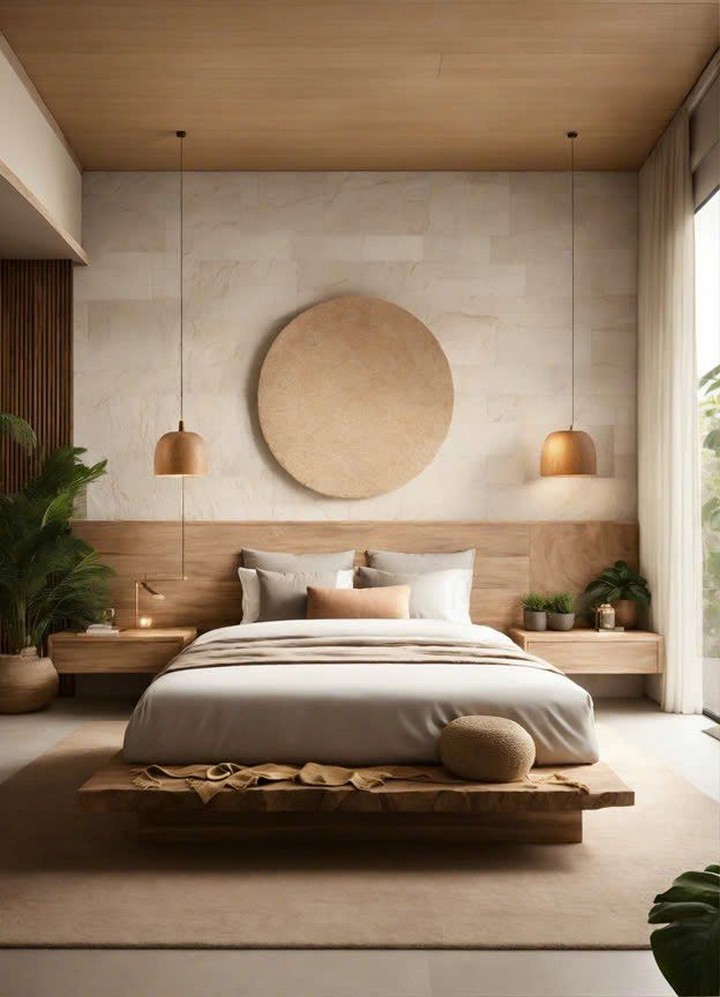
If your bedroom must accommodate a workspace, choose solutions that can be completely concealed when not in use:
- Drop-down desk that folds into wall
- Secretary desk with closable front
- Murphy bed with integrated desk that transforms when the bed is closed
40. Seasonal Rotation System
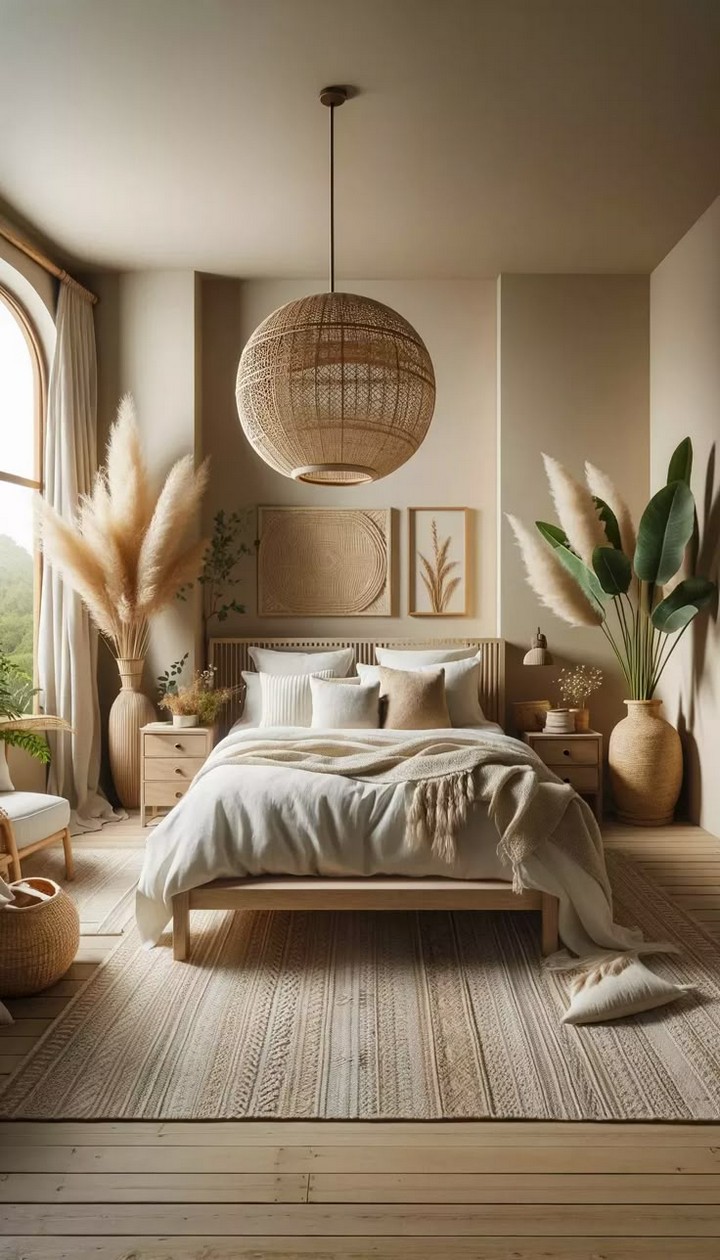
Embrace true minimalism by creating a rotation system for textiles and accessories. Store off-season items away and switch them seasonally—perhaps heavier textures and warmer tones in winter, lighter materials and slightly cooler earth tones in summer.
Implementing Your Earth-Tone Minimalist Bedroom
Starting Your Transformation

Begin your bedroom transformation with these practical steps:
- Assess your current space: What elements already align with earth-tone minimalism? What needs to change?
- Create a mood board: Collect inspiration images that resonate with your personal vision of minimalist earth tones.
- Declutter thoroughly: Before adding anything new, remove items that don’t serve your vision.
- Start with wall color: Your wall color sets the foundation for the entire palette.
- Add furniture and textiles in layers: Begin with larger pieces and gradually add smaller elements.
Maintaining Minimalist Principles
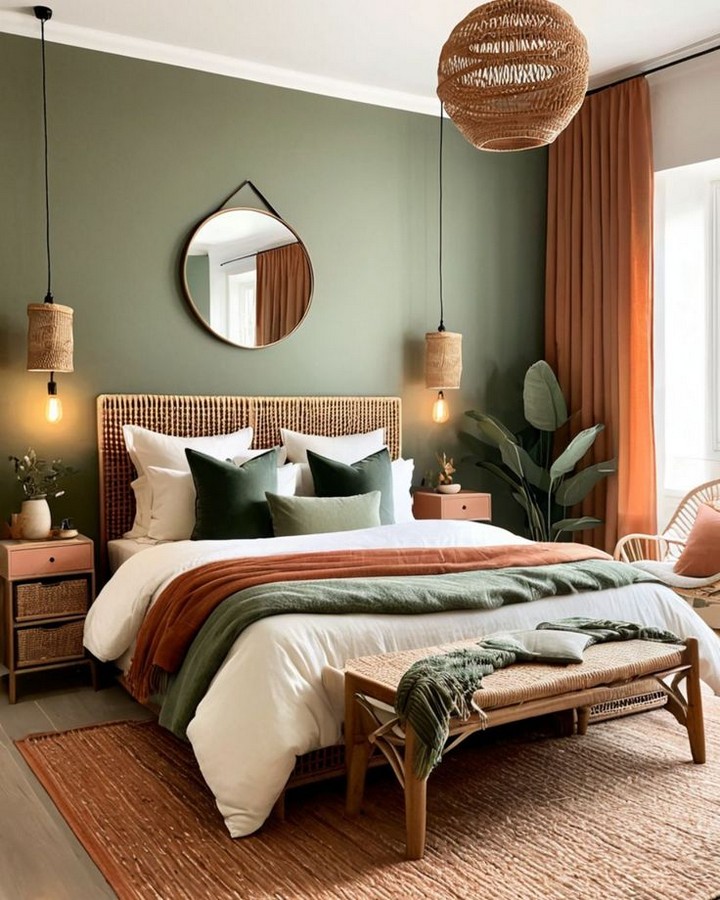
To preserve the integrity of your minimalist space:
- Implement the “one in, one out” rule for new purchases
- Regularly assess items for continued value and relevance
- Create hidden storage systems for seasonal or occasionally used items
- Develop daily tidying habits to maintain clutter-free surfaces
Personalizing Without Compromising
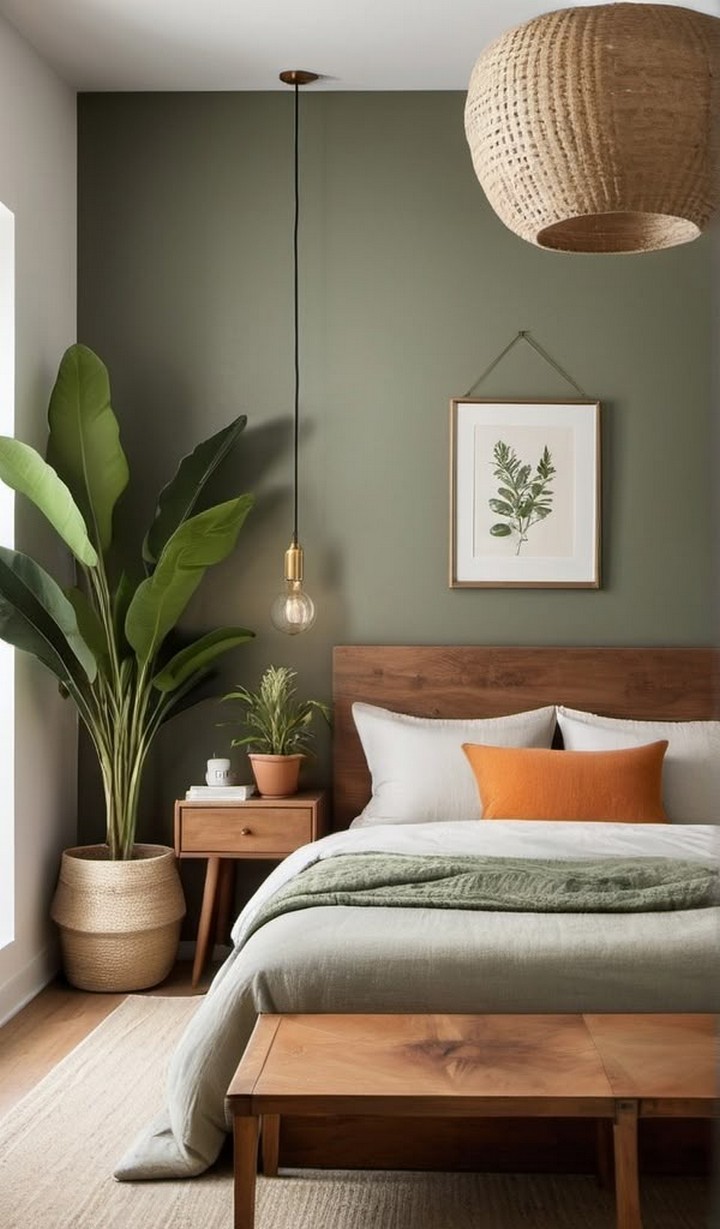
A truly successful minimalist bedroom reflects your personality while maintaining simplicity. Consider these personal touches that don’t create visual clutter:
- A single framed photograph with special meaning
- A small collection of beloved books on a floating shelf
- A handcrafted item from your travels
- A signature scent through a simple essential oil diffuser
The Benefits of Earth-Tone Minimalist Bedrooms
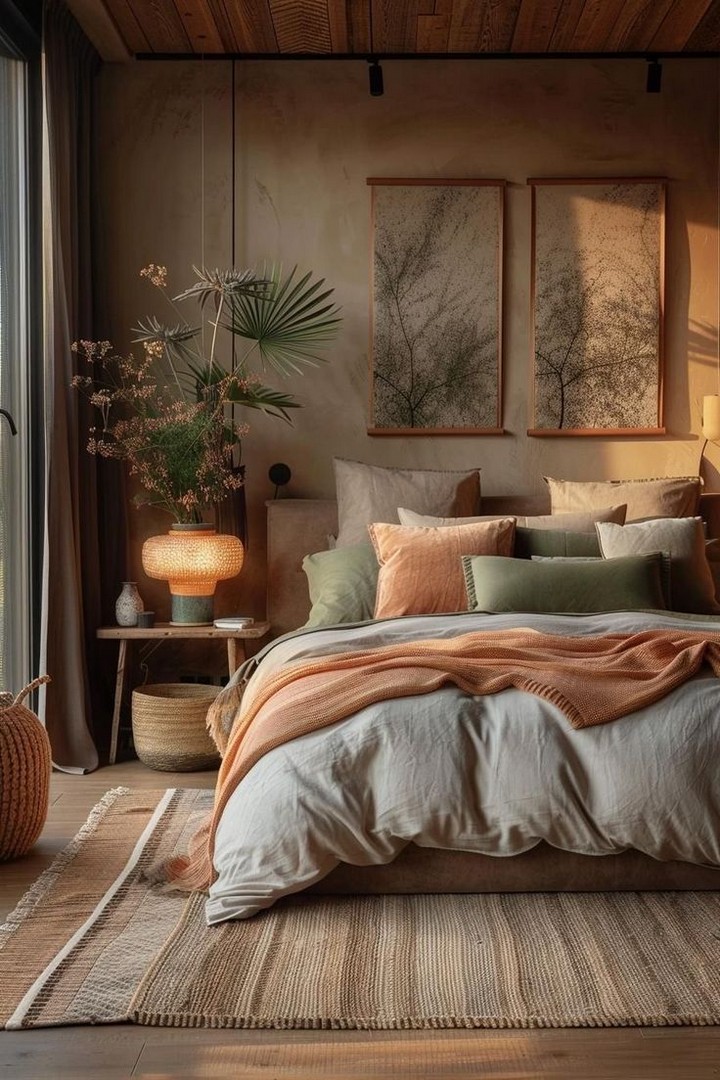
Beyond aesthetics, this design approach offers tangible benefits:
Improved Sleep Quality
Research shows that neutral color palettes and clutter-free environments promote better sleep by reducing visual stimulation and creating calm.
Reduced Stress and Anxiety
Minimalist spaces have been linked to lower stress levels and improved focus, as they reduce the mental load of visual processing and decision-making.
Enhanced Sustainability
By focusing on fewer, higher-quality items, you’ll naturally consume less and create less waste over time.
Timeless Design Longevity
Unlike trend-driven designs, earth-tone minimalism rarely feels dated, saving you from frequent redecorating costs and efforts.
Creating Your Earth-Tone Sanctuary
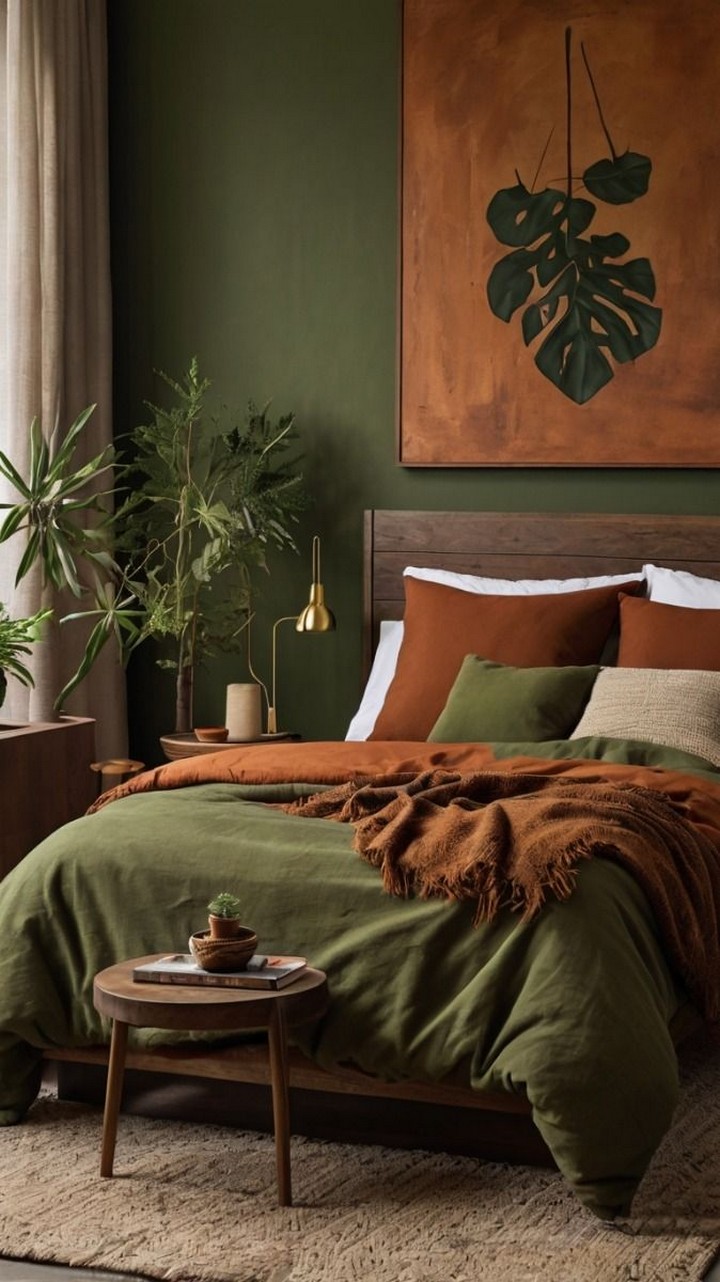
The minimalist earth-tone bedroom represents more than just a design style—it’s a conscious approach to creating a sanctuary that supports wellbeing. By embracing these 40 ideas with your personal interpretation, you can create a space that feels both deeply personal and universally appealing.
Your bedroom should ultimately reflect your unique needs and preferences while honoring the core principles of minimalist design: intentionality, quality, and harmony. The earth tone palette connects this contemporary approach to something more timeless our inherent connection to the natural world and its soothing, grounding qualities.
As you implement these ideas, remember that true minimalism is not about deprivation but about curation—selecting only what truly enhances your life and space. The result will be a bedroom that not only looks beautiful but feels like a genuine retreat from the complications of modern life.
Ready to Transform Your Bedroom?
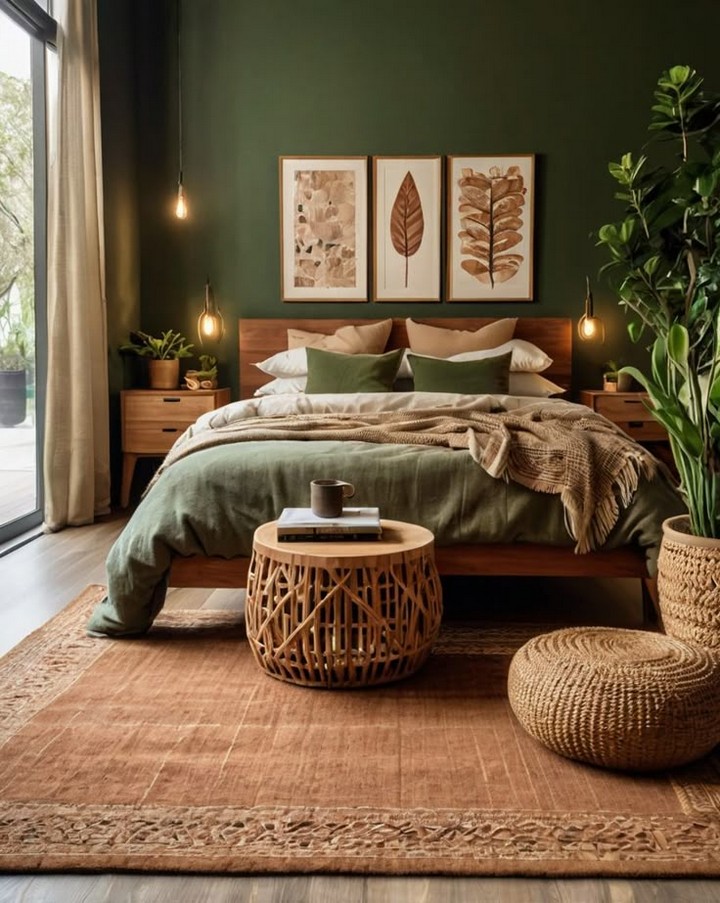
Have you implemented any of these minimalist earth-tone ideas in your bedroom? Which approach resonates most with your personal style? Share your experiences or questions in the comments below! And if you found these ideas helpful, consider sharing this article with friends who might be looking to create their own minimalist sanctuary.
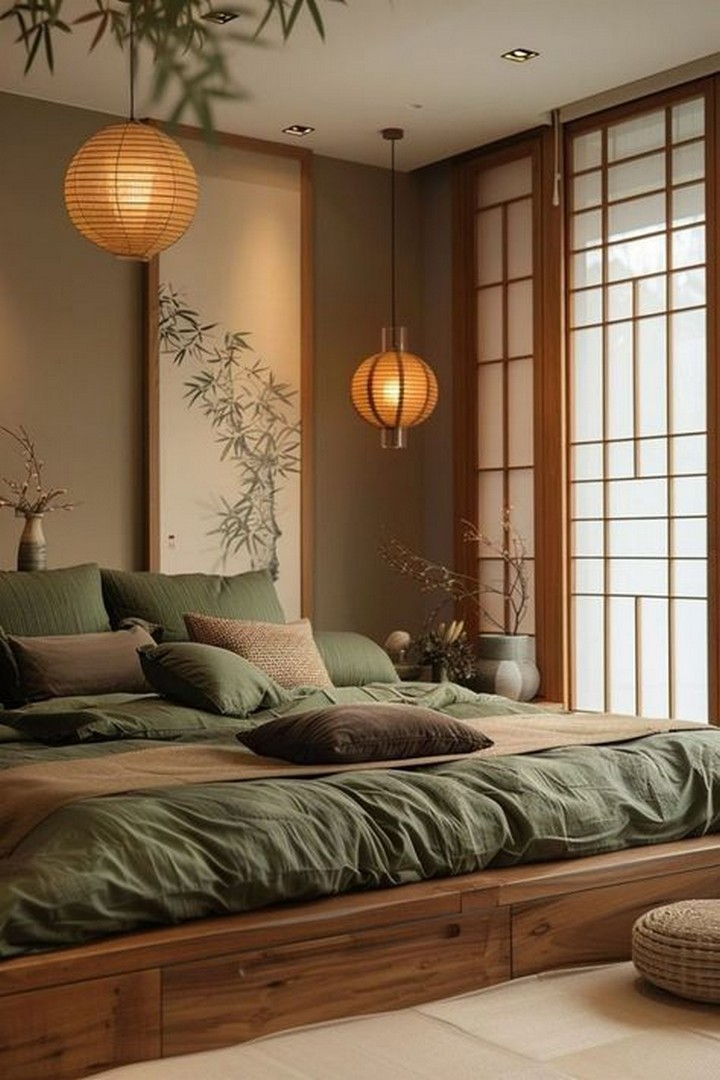
For more inspiration on minimalist living and design, explore our related articles on sustainable furniture choices, mindful organization techniques, and color psychology in home design.
Sweet dreams and happy decorating! 🌿🛏️

